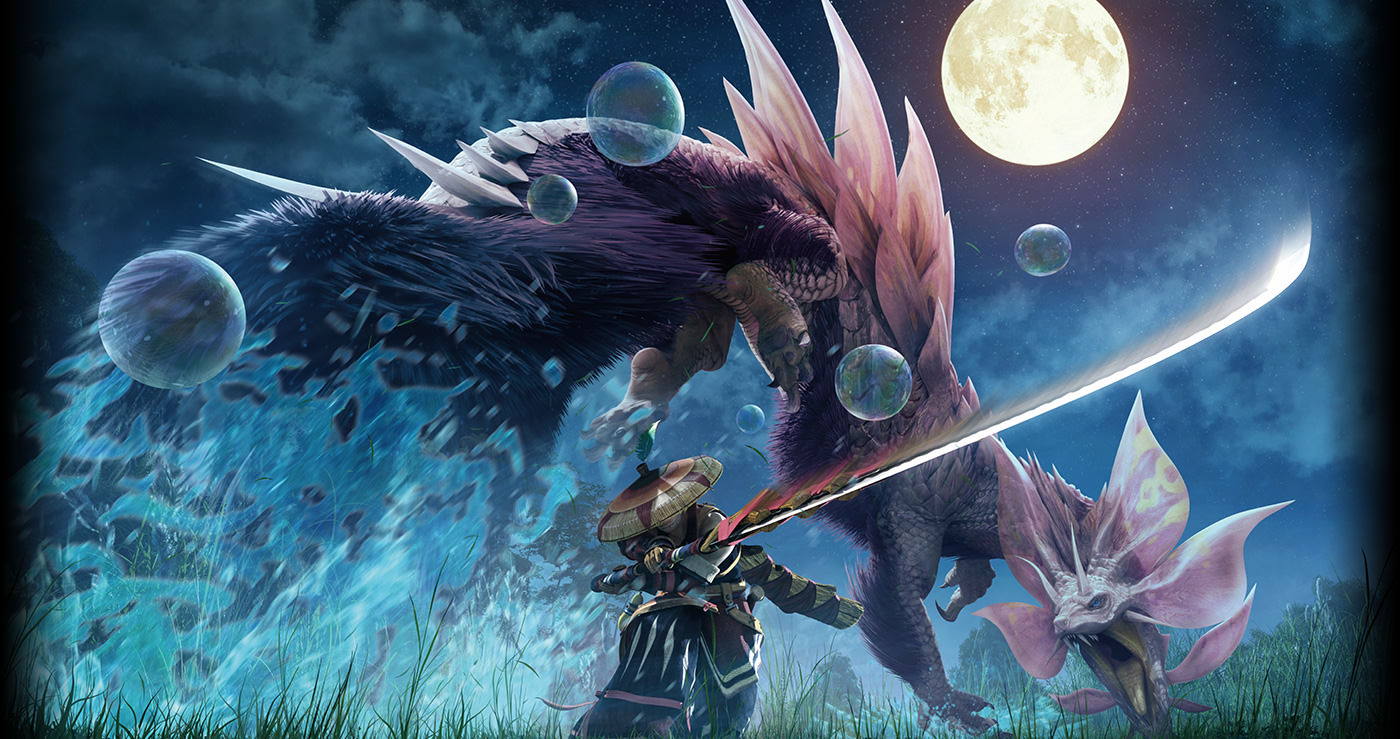
Carapaceons, & Piscine Wyverns
Table of Contents
-
Leviathans
- 2Ludroth (CR 1)
- 2Royal Ludroth (CR 5)
- 3Uroktor (CR 1/2)
- 3Agnaktor (CR 6)
- 4Gobul (CR 7)
- 6Nibelsnarf (CR 8)
- 7Mizutsune (CR 11)
- 8Lagiacrus (CR 14)
-
Amphibians
- 10Tetsucabra (CR 4)
- 11Zamite (CR 1/2)
- 12Zamtrios (CR 5)
-
Carapaceon
- 13Hermitaur (CR 1/2)
- 14Daimyo Hermitaur (CR 9)
- 15Ceanataur (CR 1/2)
- 16Shogun Ceanataur (CR 13)
- 17Shen Gaoren (CR 30)
-
Piscine Wyverns
- 19Cephalos (CR 2)
- 20Cephadrome (CR 7)
- 21Delex (CR 1/8)
- 21Gajau (CR 1)
- 22Plesioth (CR 9)
- 23Jyuratodus (CR 11)
- 24Lavasioth (CR 13)
-
Conditions & Poisons
- 7Slick
- 1Waterblight
Poison: Waterblight
A creature effected by waterblight has their stamina drained
- On the creatures turn, it can use either an Action or a Bonus Action, not both.
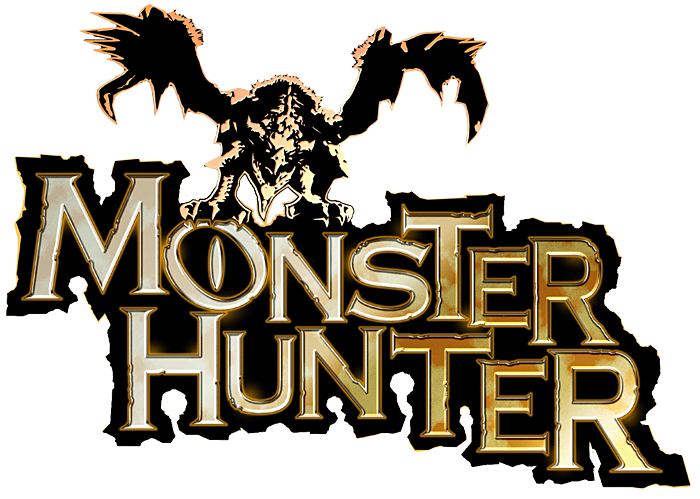
Leviathans
The Leviathan monster species, are identified by their similar appearance to crocodiles. They are also known to survive in underwater conditions, while others throughout magma in volcanoes. Fighting one almost always involves underwater combat; a leviathan is always guaranteed at some point to retreat to the depths of the oceans or lakes. They are almost always more adept at fighting underwater, while most adventurers are hindered by the liquids. Fighting one requires at least a modest proficiency in underwater fighting, and, barring any skill in that, a measure of luck to coax the Leviathan on land.
Ludroth
Ludroth are mostly yellow-green in coloration, with long, sinewy bodies that enable swift and sweeping underwater movements to confuse their prey. Their claws are stubby, but effective, and their strong tails end in reinforced bony segments. Powerful jaws allow for moderately strong biting attacks. The majority of Ludroth are female, and form harems around the male Royal Ludroth.
Ludroth
Medium leviathan, unaligned
- Armor Class 12 (natural armor)
- Hit Points 66 (12d8+12)
- Speed 30 ft., swim 30 ft.
STR DEX CON INT WIS CHA 16 (+3) 12 (+1) 13(+1) 8 (-1) 10 (+0) 7 (-2)
- Senses passive Perception 10
- Languages -
- Challenge 1 (200 xp)
Charge. If the ludroth moves at least 20 ft. straight toward a target and then hits it with a Headbutt Attack on the same turn, the target takes an extra 5 (2d4) bludgeoning damage. If the target is a creature, it must succeed on a DC 13 Strength saving throw or be knocked prone.
Actions
Headbutt. Melee Weapon Attack: +5 to hit, reach 5 ft., one target. Hit 7 (1d8 + 3) bludgeoning damage.
Claws. Melee Weapon Attack: +5 to hit, reach 5 ft., one target. Hit 6 (1d6 + 3) slashing damage. The target must make a DC 11 Constitution saving throw or become poisoned with waterblight for 1 minute on a failed save, or half as much damage and is not poisoned on a successful save. The target can repeat the saving throw at the end of each of its turns, end the poison on a successful save.
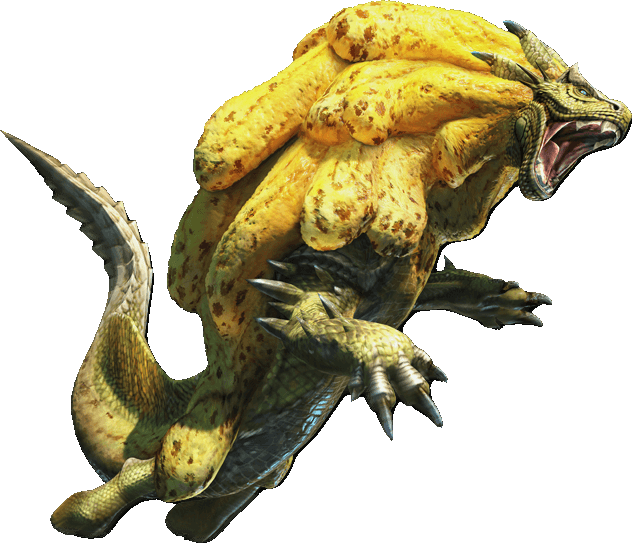
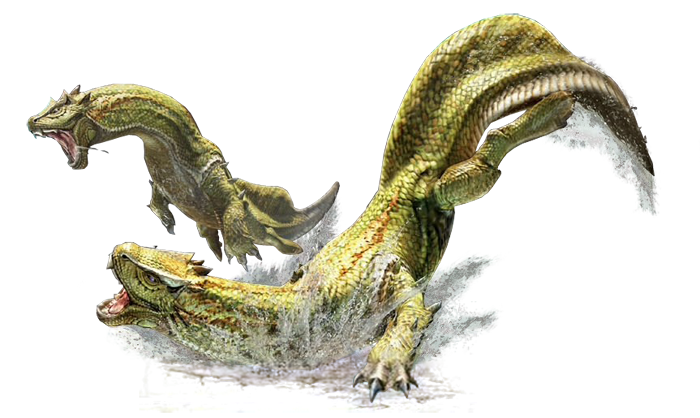
Royal Ludroth
Large leviathan, unaligned
- Armor Class 15 (natural armor)
- Hit Points 135 (18d10+36)
- Speed 30 ft., swim 40 ft.
STR DEX CON INT WIS CHA 18 (+4) 14 (+2) 15 (+2) 8 (-1) 13 (+1) 7 (-2)
- Senses passive Perception 11
- Languages -
- Challenge 5 (1,800 xp)
Actions
Multiattack. The royal ludroth makes two claw attacks.
Claws. Melee Weapon Attack: +7 to hit, reach 5 ft., one target. Hit 11 (2d6 + 4) slashing damage. The target must make a DC 14 Constitution saving throw, or become poisoned with waterblight for 1 minute. The target can repeat the saving throw at the end of each of its turns, end the poison on a successful save.
Mucus Spit (recharge 5-6). The royal ludroth spits a glob of mucus at target creature, the target must make a DC 15 Dexterity saving throw, taking 35 (10d6) bludgeoning damage and becomes poisoned with waterblight for 1 minute on a failed save, or half as much damage and is not poisoned on a successful save. The target can repeat the saving throw at the end of each of its turns, end the poison on a successful save.
Royal Ludroth
It has a crown-like crest composed of several finger-like appendages tipped with black spikes as well as a large, spongy yellow mane. The Royal Ludroth has a long, serpentine body with four squat limbs. Its hind pair of legs are shaped like paddles for swimming, and its foremost pair are more muscular, tipped with developed digits ending in long black claws. Its jaws are lined with shear-like plates in the place of teeth.
As the alpha male, Royal Ludroth will usually roam around with a harem of females in tow. It is an aggressive creature, and will lash out at anything that threatens it or its clan.
Uroktor
Leviathans that inhabit volcanoes. Noted for swarming around larger monsters' kills in order to feed. Uroktor rarely hunt for themselves, but are known for being highly aggressive. Just like their adult form, the Agnaktor, they have the remarkable ability to tunnel through solid volcanic rock. Uroktor are distinguished by their reddish-purple skin, which protects them from both the sweltering heat and volcanic predators. Uroktor will defend themselves from other monsters and adventurers alike, but will flee if they feel overwhelmed.
Agnaktor
Also known as Fire-Pike Wyverns, Agnaktor has developed the remarkable ability to swim through lava, meaning it can both sneak up on prey and escape from a more powerful enemy. It has a very strong beak, which it uses to burrow straight through hard volcanic rock at incredible speeds. While swimming it swallows some of the lava and stores it in its body so that it can produce its powerful lava beam. Produced between Agnaktor's scales is a non-flammable substance that never burns. This substance allows Agnaktor to coat its hide with lava and swim in lava. The molten rock on its body will eventually harden into a thick armor of rock, but when the Agnaktor touches lava, its coating becomes soft again.
Despite Agnaktor being powerful predators, they are known to leave their habitat when a powerful monster appears or during a volcanic eruption. During the Breeding Season, both males and females will swim to the summit of an active volcano to mate, this is also where most Agnaktor learn the dig through the ceiling technique. The female will then make a nest somewhere near the top and then give live birth to 2-30 individuals at a time.
Uroktor
Medium leviathan, unaligned
- Armor Class 13 (natural armor)
- Hit Points 55 (10d8+10)
- Speed 30 ft., burrow 30 ft.
STR DEX CON INT WIS CHA 14 (+2) 10 (+0) 12(+1) 3 (-4) 8 (-1) 7 (-2)
- Senses tremorsense 60 ft., passive Perception 9
- Languages -
- Challenge 1/2 (100 xp)
Actions
Bite. Melee Weapon Attack: +4 to hit, reach 5 ft., one target. Hit 6 (1d8 + 2) piercing damage.
Fire Spit. Melee Weapon Attack: +4 to hit, range 60/100 ft., one target. Hit 5 (1d6 + 2) fire damage.
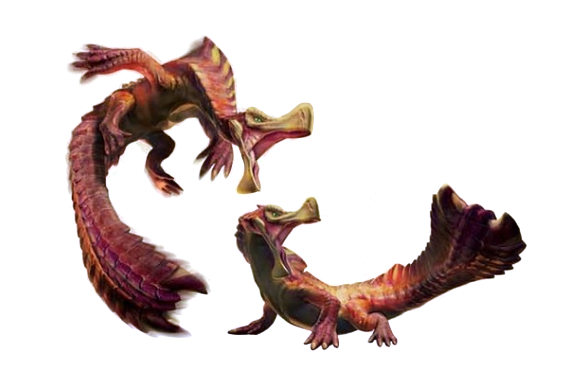
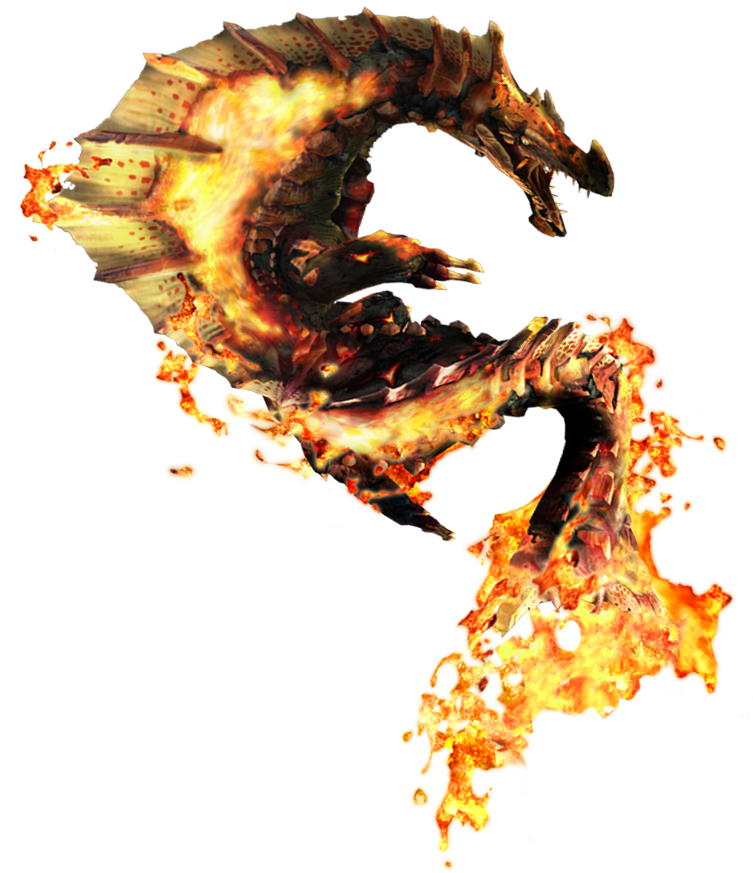
Agnaktor
Huge leviathan, unaligned
- Armor Class 16 (natural armor)
- Hit Points 152 (16d12+48)
- Speed 30 ft., burrow 40 ft., swim 40 ft.
STR DEX CON INT WIS CHA 17 (+3) 14 (+2) 16 (+3) 10 (+0) 11 (+0) 7 (-2)
- Damage immunities fire
- Senses passive Perception 10
- Languages -
- Challenge 6 (2,300 xp)
Volcanic Swimmer. The agnaktor can swim in lava as if it was water.
Lava Armor. The agnaktor’s body is covered in a lava-like armor which hardens when cooled and softens when heated. At the start of its turn, if agnaktor is above ground, it gains +1 AC and its movement speed is reduced by 5 feet. to a maximum of +4 AC and -20 feet of movement. If the agnaktor takes fire damage, the bonus AC from this skill is reduced by 1 and movement is increased by 5 feet. The agnaktor can reset this effect by staying submerged in lava or underground for one round.
Actions
Multiattack. The agnaktor makes two bite attacks.
Bite. Melee Weapon Attack: +6 to hit, reach 5 ft., one target. Hit 13 (3d6 + 3) piercing damage.
Magma Beam (recharge 5-6). The agnaktor exhales magma in a 60-foot line that is 5 feet wide. Each creature in that line must make a DC 14 Dexterity saving throw, taking 31 (9d6) fire damage on a failed save, or half as much damage on a successful one.
Gobul
Gobul is a uniquely evolved Leviathan reminiscent of angler and puffer fish. Its body is covered in purple scales, and a bright, bioluminescent lure dangles from its forehead. It possesses a gargantuan mouth filled with equally formidable teeth. Its back features an array of retractable spines, and its tail is tipped with quills containing powerful neurotoxins, which can paralyze both predator and prey. The Gobul doesn't produce these toxins, but receives them through its food. The neurotoxin exists in the ecosystem in small quantities and gets concentrated to the top of the food chain. Gobul uses this toxin mainly for self-defense, but they will sometimes use it to paralyze its prey during mimicry.
Gobul's massive mouth and throat mean that it can swallow prey almost as large as itself completely whole. Its lure can violently emit blinding flashes of light to disorient prey to make for an easy meal. Luminescent micro-organisms are cultured in Gobul's lantern sphere, and are stimulated by shaking. It could be said that the microbial organisms that are emitting the intense light have a symbiotic relationship with the Gobul. Another theory suggests that by shaking its lantern, Gobul secretes a substance that causes a chemical reaction with the microbes to cause the flash.
It is capable of puffing out its body like a balloon to appear more imposing.
Gobul has a display of whiskers on its chin, mimicking air weeds. It leaves these whiskers to flow in the water to both hide itself and draw prey in. This natural camouflage ability is enhanced further by Gobul's ability to change the color of its skin, like a chameleon allowing it to blend into the river floor and remain undetected by prey.
Gobul isn't particularly aggressive, preferring to hide in the sediment at the bottom of the river. However, when drawn from its hiding place by hunger or agitated, it shows a surprising ability to fend off foes, outmaneuvering them in the water and sucking them into its mouth. It will even attempt to fight predators on land, where it is at a disadvantage, before retreating back to the water. It seems to be enemies with Royal Ludroth, for hunters have seen the two attack each other for territory and/or food.
Despite the Guild knowing about young Gobuls, they know very little about the adults. Gobul found at sea have been found to have developed eggs within there body, and it is believed that they swim out to sea to breed. However, it is only a theory as no fully developed adults have been discovered. It is believed that the adults are either hidden mimicking the sea bottom or have a completely different appearance.
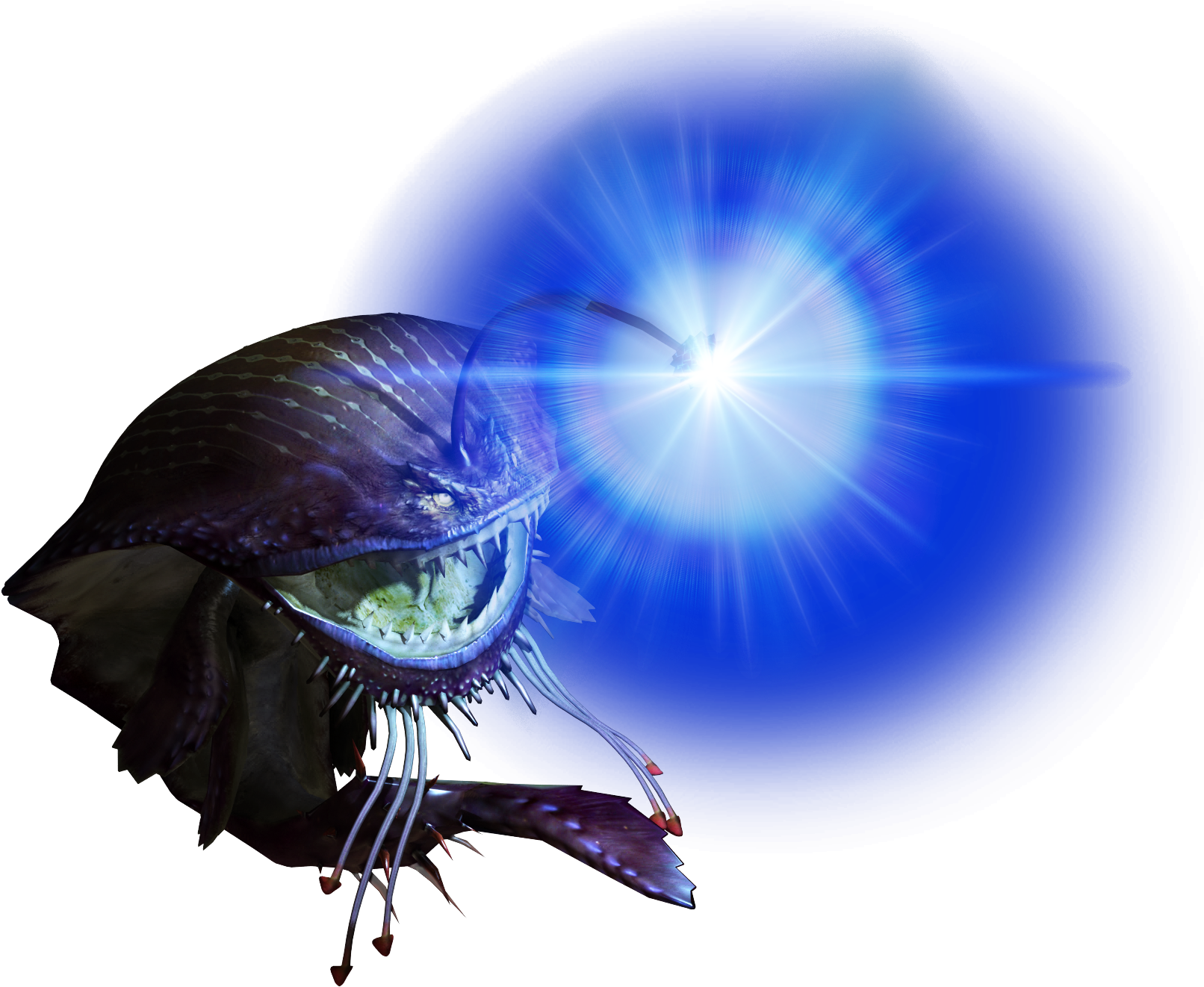
Gobul
Large leviathan, unaligned
- Armor Class 14 (natural armor)
- Hit Points 133 (14d10 + 56)
- Speed 30 ft., swim 40 ft.
STR DEX CON INT WIS CHA 19 (+4) 15 (+2) 18 (+4) 7 (-2) 12 (+1) 14 (+2)
- Skills Perception +4, Stealth +5
- Condition Immunities poisoned, paralyzed
- Senses passive Perception 14
- Languages -
- Challenge 7 (2,900 xp)
Lure. While hidden, the gobul can use the lure on its head to create a mesmerizing flash of lights. Any creature that can see the lure, must make a DC 13 Wisdom saving throw or be charmed for 1 minute by the gobul or until the gobul something harmful to the creature. While charmed in this way, the creature may only use its turn to move towards the lure.
Natural Camouflage. While the gobul remains motionless on river bed, lake bottom, or sea floor, it is indistinguishable from common water plants.
Amphibious. The gobul can breathe air and water.
Actions
Multiattack. The gobul makes two attacks: one with its bite and one with its tail. It can't make both attacks against the same target.
Tail. Melee Weapon Attack. +7 to hit, reach 10 ft., one target. Hit 15 (2d10 + 4) piercing damage, or 20 (3d10 + 4) piercing damage while enlarged.. On hit, the target must make a DC 15 Constitution saving throw or become poisoned for 1 minute. While poisoned in this way, the target is paralyzed. The target can repeat the saving throw at the end of each of its turns , ending the effect on itself on a success.
Bite. Melee Weapon Attack. +7 to hit, reach 5 ft., one target. Hit 13 (2d8 + 4) piercing damage, or 17 (3d8 + 4) piercing damage while enlarged.
Enlarge (Recharges after a Short or Long Rest). For 1 minute, the gobul magically increases in size, along with anything it is wearing or carrying. While enlarged, the gobul is Huge, rolls one additional weapon damage die on Strength-based weapon attacks (included in the attacks), and makes Strength checks and Strength saving throws with advantage. If the gobul lacks the room to become Large, it attains the maximum size possible in the space available.
Swallow. The gobul makes one bite attack against a Medium or smaller creature that is paralyzed or charmed. If the attack hits, the target takes the bite's damage and the target is swallowed. While swallowed, the creature is blinded and restrained, it has total cover against attacks and other effects outside the gobul, and it takes 10 (3d6) acid damage at the start of each of the gobul's turns. The gobul can swallow 3 creatures while enlarged, or 2 when not enlarged.
If the gobul takes 19 damage or more on a single turn from a creature inside it, the gobul must succeed on a DC 17 Constitution saving throw at the end of that turn or regurgitate all swallowed creatures, which fall prone in a space within 10 feet of the gobul. If the gobul dies, a swallowed creature is no longer restrained by it and can escape from the corpse by using 10 feet of movement, exiting prone.Vortex (recharge 5-6). While underwater, the gobul opens its mouth swallowing everything in a 30-foot cone. Each creature in that area must make a DC 15 Strength saving throw. On a fail, the gobul swallows that creature without making a bite attack, even if the creature is not paralyzed or charmed. If the gobul cannot swallow all the creatures, it swallows the closest ones first and may use a bonus action to bite one additional creature that failed the saving throw.
Blinding Flash The gobuls bioluminescent lure emit blinding flashes of light in a 30-foot radius. Each creature in the area, must make a DC 15 Constitution saving throw or become blind until the end of their next turn.
Legendary Actions
The gobul can take 1 legendary action, choosing from the options below. The legendary action option can be used at the end of another creatures turn. The gobul regains the spent legendary action at the start of its turn.
Blind. The gobul uses Blinding Flash.
Devour. The gobul uses its bite attack; or Swallow on a paralyzed or charmed creature.
Roll (Must be Enlarged). The gobul extends it retractable spines on its back. It then can move up to half its movement speed, without provoking an attack of opportunity, by rolling over and impaling anything in its path. Each creature in that area must make a DC 13 Dexterity saving throw, taking 11 (2d6 + 4) piercing damage and are paralyzed for 1 minute on a failed save. On a successful save the creature takes half damage and is not paralyzed. A creature can make a DC 15 Constitution saving throw at the end of each of its turns, ending the effect on itself on a success.
Nibelsnarf
Huge leviathan, unaligned
- Armor Class 17 (natural armor)
- Hit Points 152 (16d12+48)
- Speed 30 ft., burrow 30 ft.
STR DEX CON INT WIS CHA 18 (+4) 15 (+2) 17 (+3) 13 (+1) 12 (+1) 14 (+2)
- Saving Throws Dex +5, Con +6, Wis +4
- Senses tremorsense 60 ft., passive Perception 11
- Languages -
- Challenge 8 (3,900 xp)
Desert Camouflage. The nibelsnarf has advantage on Dexterity (Stealth) checks made to hide in desert terrain while burrowed.
Actions
Multiattack. The nibelsnarf makes three bite attacks.
Bite. Melee Weapon Attack: +7 to hit, reach 5 ft., one target. Hit 17 (3d8 + 4) piercing damage.
Wind Tunnel (recharge 5-6). The nibelsnarf exhales sand and debris swallowed in a 30-foot cone., Each creature in the area must make a DC 15 Dexterity saving throw, taking 31 (9d6) bludgeoning damage on a failed save, or half as much damage on a successful save.
Reactions
Sand Cloud. When a creature makes an attack against the nibelsnarf, it can use its reaction to expel a large sand cloud from the gills on the back of its head. Any creature within 5 feet of the nibelsnarf and flanking it must make a DC 15 Strength saving throw or be knocked prone. If a creature fails the save by more than 5 they are also pushed 10 feet away from the nibelsnarf.
Nibelsnarf
Leviathans that have adapted to live in sandy areas. They burrow through sand and locate prey aurally, then suck both the target and any surrounding sand into their maws. It has the remarkable ability to swim in sand, shared only with a few monsters, and its streamlined body helps it move through it at great speeds. They are capable of burrowing into the sand and of disguising themselves as sand dunes to ambush prey.
It has a huge mouth for eating its prey such as Rhenoplos in one bite, like the Gobul. It locates its prey with hearing. It shares this trait with the Agnaktor, which is also a land dwelling Leviathan. It is possible that the two developed this ability because they spend most of their time underground. It spits sand at predators that try to attack it. Its eyes are on top of its head, so it can see its prey easier when lurking in the sand; however, their placement also makes it difficult for it to see anything directly in front of it. They also have salamander-like "gills" which it uses to filter out sand and absorb minerals in the sand. It uses this clearing of the sand as an attack, as the sand shoots from the gills at a high enough speed to hurt individuals caught in the blast. Nibelsnarf seem to have very strong stomachs, capable of withstanding a bomb exploding in it. Inside the massive mouth of this predator is an enlarged uvula that stores nutrients. This organ is essential to the leviathan's survival within the arid Sandy Plains.
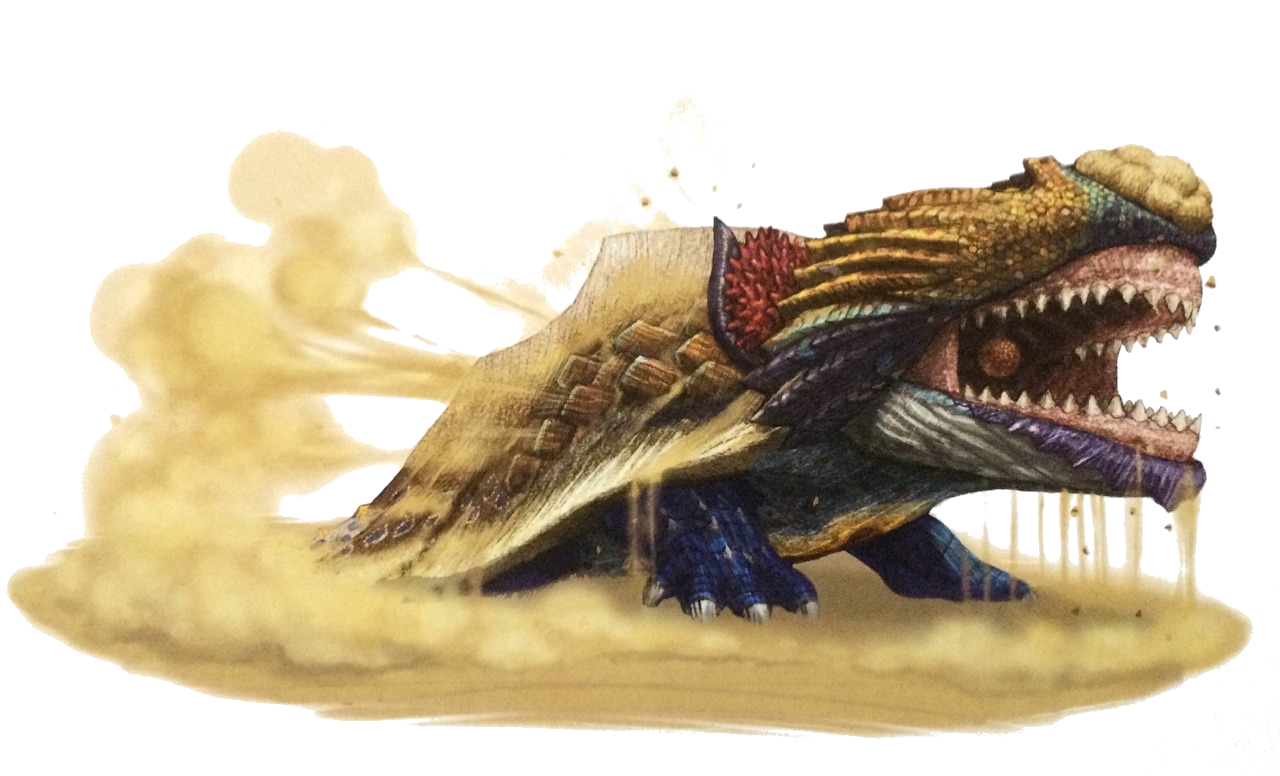
Mizutsune
Like most other Leviathans, Mizutsune has a long, slender body. However, it is one of the few Leviathans to actually have fur on its body. This fur covers its chest, underbelly, legs and tail. Its scales are light colored and resemble those of a fish. Its head has a long snout and is beautifully adorned by many fin-like appendages. These fins are pink with yellow markings, and they can also be seen on its back and tail. Its feet are said to be quite different from other Leviathans and allow Mizutsune to move swiftly on land.
Mizutsune's most unique adaptation is its ability to produce bubbles. It is able to produce the bubbles by using special fluid secretions, produced from its own body along with water, and rubbing its hairs in the secretions. These stiff yet soft purple hairs are found on its chest, tail, legs, and sides. The hairs are used for sliding on the fluids it produces, spreading the fluids, and even using the fluids to produce more bubbles. Mizutsune can also breath these bubbly fluids from its mouth. It is known to use the bubbles it produces both offensively and defensively in battle. It uses the bubbles to help it move faster and to make it more flexible in battle, while simultaneously impeding the movement of any foes. In order to stop itself quickly while moving, Mizutsune has special hook-like claws that allow it to stop sliding quickly to face threats and not leave itself open. Despite Mizutsune's strange appearance, the fins it has actually act as receptors for detecting the presence of predators and prey coming through vibrations in the secretions. Like a snake, Mizutsune's teeth are recurved to prevent prey from escaping easily. Its jaws are even designed like a snake to an extent, even being able to open its mouth wide and swallow some large prey. It can also fire pressurized jets of water from its mouth, much like Plesioth.
Mizutsune are rather calm in nature until provoked. They prefer to be left alone resting near large bodies of water, while covered in their special secretions. They prefer to avoid confrontations, however, will defend themselves if need be. Once a threat has left, Mizutsune won't chase after the threat but will instead let it go. Though Mizutsune are usually calm, they are known to turn aggressive during Breeding Season. Mizutsune become aggressive or even berserk during their Breeding Season. In this season, it is not a good idea to go fishing from them being known to injure people due to their blind rage. Male Mizutsune have large fins and are able to flash their fins red to show emotion to the female Mizutsune, in order to attract them.
Condition: Slick
A creature who is slick is covered in a slippery or slimy liquid. This liquid coats the body making it difficult to move or avoid attacks without slipping.
- A creature who is slick has disadvantage on Dexterity saving throws.
- A creature may only move up to half its speed while under this effect.
- A creature has disadvantage when attempting to grapple a creature, but advantage when attempting to escape a grapple when using acrobatics.
A creature can use its action on itself or another adjacent creature to wipe off the liquid, removing the effect.
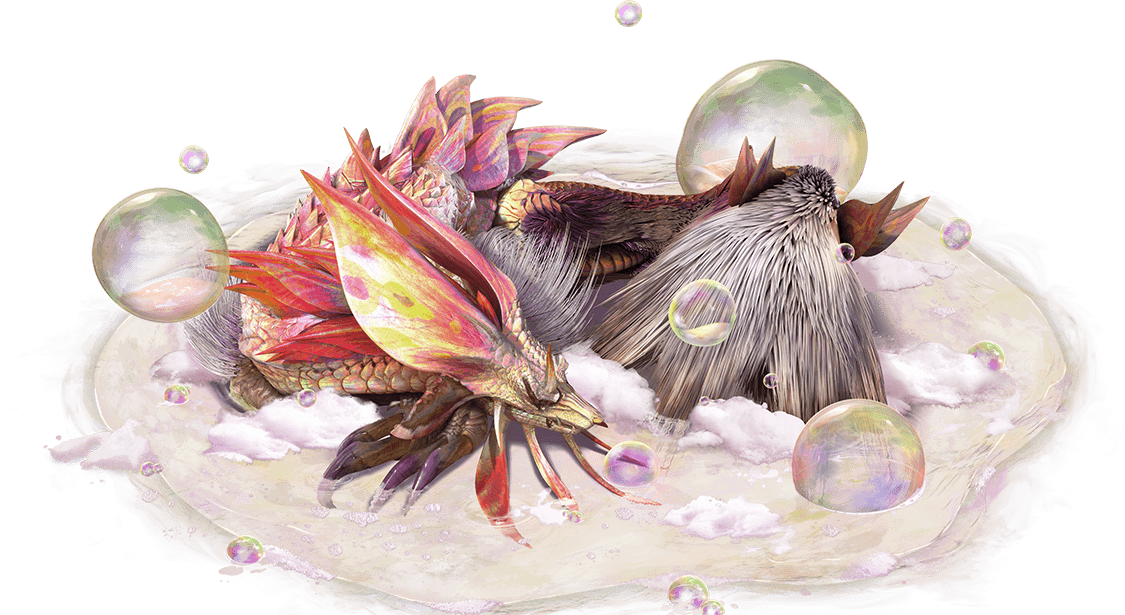
Mizutsune
Huge leviathan, unaligned
- Armor Class 17 (natural armor)
- Hit Points 184 (16d12+80)
- Speed 50 ft., swim 40 ft.
STR DEX CON INT WIS CHA 17 (+3) 23 (+6) 21 (+5) 12 (+1) 15 (+2) 10 (+0)
- Saving Throws Dex +10, Wis +6
- Skills Acrobatics +10, Perception +6
- Condition Immunities slick
- Senses darkvision 60 ft. passive Perception 16
- Languages -
- Challenge 11 (7,200 xp)
Oiled Body. The mizutsune has advantage on Dexterity (acrobatic) checks.
Actions
Multiattack. The mizutsune makes three attacks: one with its bite and two with its tail. It can make both attacks against the same target.
Tail. Melee Weapon Attack: +10 to hit, reach 10 ft., one target. Hit 25 (3d12 + 6) bludgeoning damage. On hit, the creature is Slick.
Bite. Melee Weapon Attack: +10 to hit, reach 5 ft., one target. Hit 19 (3d8 + 6) piercing damage. If the target is a Large or smaller creature, it is grappled (escape DC 14). Until this grapple ends, the mizutsune can't use its bite on another target.
Bubble Prison. Range Weapon Attack: +10 to hit, range 80/320 ft., one Large or smaller creature. Hit: The creature is Slick and enclosed in a bubble of shimmering force for 1 minute or until the bubble is destroyed. Nothing, not physical Objects, energy, or other spell effects, can pass through the bubble, in or out, though a creature in the Sphere can breathe there. A creature inside of the bubble has disadvantage on attacks due to its slippery nature. The bubble has AC 15, 30 hit points, resistance to bludgeoning damage, immunity to poison and psychic damage, but vulnerable to piercing damage. At the end of the mizutsune's turn all bubbles rise 10 feet higher into the air.
Hydropump (recharge 5-6). The mizutsune releases a high pressure stream of water in an 60-foot line that is 5 feet wide. Each creature in that line must make a DC 18 Dexterity saving throw, taking 55 (10d10) cold damage on a failed save, or half as much damage and not on a successful one.
Reactions
Tail Sweep. When a creature is slick and starts its turn within 10 feet of the mizutsune. It can use its reaction to sweep its tail, hitting the targets legs. The target must then make a DC 18 Dexterity saving throw or be knocked prone.
Lagiacrus
The Lagiacrus is one of the most famous and feared Leviathan. A large water monster It sits comfortably at the top of the oceanic food chain. It is the top predator of its habitat, and even predators such as Rathalos and Rathian prefer to keep out of its way. Of course being the Lagiacrus' only real competition besides each other, the Fire Wyverns would be considered a threat to a Lagiacrus, as would a Lagiacrus to a Fire Wyvern. Lagiacrus's control of Thunder Element makes it a dangerous adversary in the aquatic habitat it resides, even for the well defended Gobul. Even Plesioth that migrate to tropical islands and flooded forests would be wary of the large and powerful leviathan as its powerful electrical attacks can easily cripple or even kill the Piscine Wyvern. This would cause Plesioth to avoid Lagiacrus at all costs. Lagiacrus are known to feed on fish, lobsters, Kelbi, Aptonoth, and Epioth.
Lagiacrus are highly aggressive Leviathans that is the "Lord of the Sea". To hunt down and capture prey, Lagiacrus will swim in a circle to form a whirlpool. These whirlpools are used to suck up fish and other prey so Lagiacrus can shock them to death before feeding on their quarry. These whirlpools are occasionally used sink boats and ships.
Lagiacrus is a large, blue aquatic leviathan , adapted to life in tropical waters. When a Lagiacrus is fully sunbathed, it turns a dry grayish-blue color and its dermal spikes turn a pale red. When it returns to the water, Lagiacrus regains a striking deep blue color and its spikes return to their original color of a very light beige.
Its hood-like structure is allows it to swim through the water much quicker along with the help of its tail and limbs. Lagiacrus are able to stay submerged underwater for up to half a day without coming out for air. The large dorsal spikes on its back are used to release its electric attacks alongside a possible electro sac below each spike. Its able to release this electricity by contracting its cells at high speeds inside its muscles. When it does this some of the electricity actually combines with some of the mucus in its mouth, allowing it to spit out lightning projectiles from its mouth. In other regions, the Lagiacrus is able to bend the lightning it creates around it, how it does this is still unknown. It is known to to come ashore to regain its strength after discharging or to rest when it's tired.
Lagiacrus
Huge leviathan, unaligned
- Armor Class 18 (natural armor)
- Hit Points 204 (24d12 + 48)
- Speed 30 ft., swim 50 ft.
STR DEX CON INT WIS CHA 16 (+3) 18 (+4) 14 (+2) 10 (+0) 11 (+0) 7 (-1)
- Saving Throws Wis +5, Cha +4
- Skills Perception +5
- Damage Immunities lightning
- Senses passive Perception 15
- Languages -
- Challenge 14 (11,500 xp)
Lightning aura. Lightning sparks off of the lagiacrus into the surrounding area. Any creature that ends its turn within 5 feet of the lagiacrus takes 3 (1d6) Lightning damage.
Legendary Resistance (2/Day). If the lagiacrus fails a saving throw, it can choose to succeed instead.
Actions
Multiattack. The lagiacrus makes two attacks, one with its bite and one with its claws.
Claws. Melee Weapon Attack: +8 to hit, reach 5 ft., one target. Hit 13 (3d6 + 3) slashing damage.
Bite. Melee Weapon Attack: +8 to hit, reach 5 ft., one target. Hit 16 (3d8 + 3) piercing damage + 3 (1d6) lightning damage.
Lightning ball (Recharge 5-6). The lagiacrus exhales a ball of lightning to a location with 60 feet of it. Each creature within a 10-foot radius of the location must make a DC 17 Dexterity saving throw, taking 60 (11d10) lightning damage on a failed save or half as much on a successful one.
Legendary Actions
The lagiacrus can take 3 legendary actions, choosing from the options below. Only one legendary action option can be used at a time and only at the end of another creatures turn. The lagiacrus regains spent legendary actions at the start of its turn.
Detect. The lagiacrus makes a Wisdom (Perception) Check.
Claw Attack. The lagiacrus makes a claw attack.
Lightning Charge (Costs 2 Actions). The lagiacrus moves up to its speed, without provoking attacks of opportunity, during this move it may move through other creatures. Any creatures the lagiacrus moves through must succeed on a DC 17 Dexterity saving throw or take 13 (3d6 + 3) lightning damage and is paralyzed until the end of their next turn.
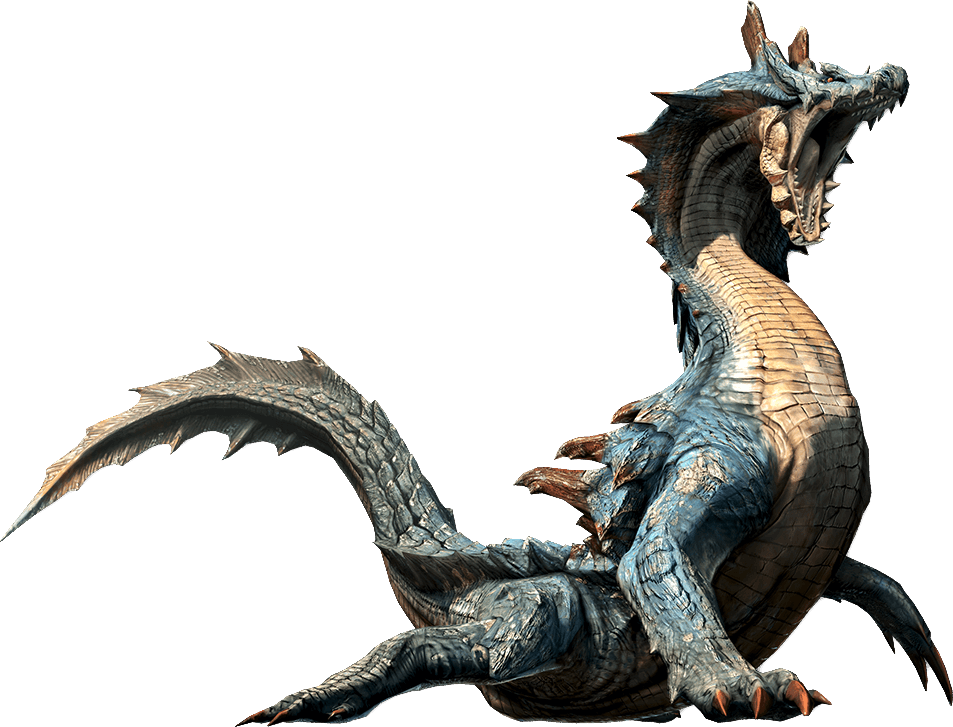
Amphibians
Amphibians are a class of monster that are superficially frog-like in body structure, with powerful, spring-like back legs and muscular forelegs. They are known to inhabit a diverse range of environments and are typically carnivorous.
Tetsucabra
Tetsucabra is a large Amphibian with a striking orange and indigo coloration. Its lower jaw harbors large tusks along with a large set of molars that are capable of crushing prey with ease. Tetsucabra also has a spiky stubby tail that swells up when angered.
The scales of a Tetsucabra is used mainly for camouflage inside caves and on them is a special oil that holds heat. Despite the look of the scales, its skin is actually flexible yet hard somewhat resembling an actual toad's skin. A Tetsucabra's skull is robust and durable enough to take a lot of damage from threats of all sorts. Though the Tetsucabra has two large tusks, these are not used for hunting. The primary function of these tusks is for defense and as means to manipulate the environment. The tusks themselves are capable weapons, but the Tetsucabra is also capable of hefting up heavy boulders. The Tetsucabra flings these boulders out of the way of its path but it can also use this as a method of attack to injure predator and prey alike. It uses these boulders as a shield against predators and hunters to prevent attacks. It also uses this to enclose small, tight areas, making it harder to maneuver. Another fact about the Tetsucabra is its ability to spit a glob of fluid at prey items. This sticky material acts as a powerful adhesive, sticking to the body and ground like glue. Even for a hunter, the adhesive quality of this material is not very strong, but it makes every movement a labor and greatly weakens the prey, leading to a reduction in stamina. When the Tetsucabra exerts itself, its tail inflates, possibly to help it balance itself as it picks up large boulders and rocks. The legs of a Tetsucabra help it perform powerful leaps, lunges, and jumps in the air to help it either ambush prey or to reach steep slopes out of its reach. A Tetsucabra's claws are powerful enough to break rock with ease and can destroy powerful armor.
Tetsucabra are highly aggressive, territorial monsters though their ecology is much like a frog. The amphibians are well-known for attacking and eating anything that moves in their line of sight and leaping from ponds in order to grab potential prey. Despite being found in ponds, they spend most of their time on land, which could suggest that they patrol their territory on land, much like Zamtrios. During the breeding season male Tetsucabra will create large holes to impress females so that they'll lay their eggs in them. When the female lays her eggs in the pit the male will quickly fertilize them. After fertilizing the eggs the male will then carry them in his mouth and he will not eat anything until the offspring are fully developed.
Tetsucabra
Large beast (amphibian), unaligned
- Armor Class 14 (natural armor)
- Hit Points 110 (13d10 + 39)
- Speed 30 ft., burrow 20 ft.
STR DEX CON INT WIS CHA 18 (+4) 14 (+2) 16 (+3) 2 (-4) 6 (-2) 6 (-2)
- Senses passive Perception 8
- Languages -
- Challenge 4 (1,100 xp)
Standing Leap. The tetsucabra's long jump is up to 20 feet and its high jump is up to 10 feet, without a running start. In addition, the tetsucabra does not incur attacks of opportunity while moving with a jump.
Dig. As a bonus action, the tetsucabra digs up a boulder (10 AC, 5hp) with its tusks granting it +3 AC. It can then use its Boulder Toss as an Action.
Actions
Multiattack. The tetsucabra makes two attack, one with its gore and one with its stomp.
Gore. Melee Weapon Attack: +6 to hit, reach 5 ft., one target. Hit 13 (2d8 + 4) piercing damage.
Stomp. Melee Weapon Attack: +6 to hit, reach 5 ft., one target. Hit 15 (2d10 + 4) bludgeoning damage.
Boulder Toss (requires Boulder). Range Weapon Attack: +4 to hit, range 30/120 ft., one target. Hit 11 (2d8 + 2) bludgeoning damage.
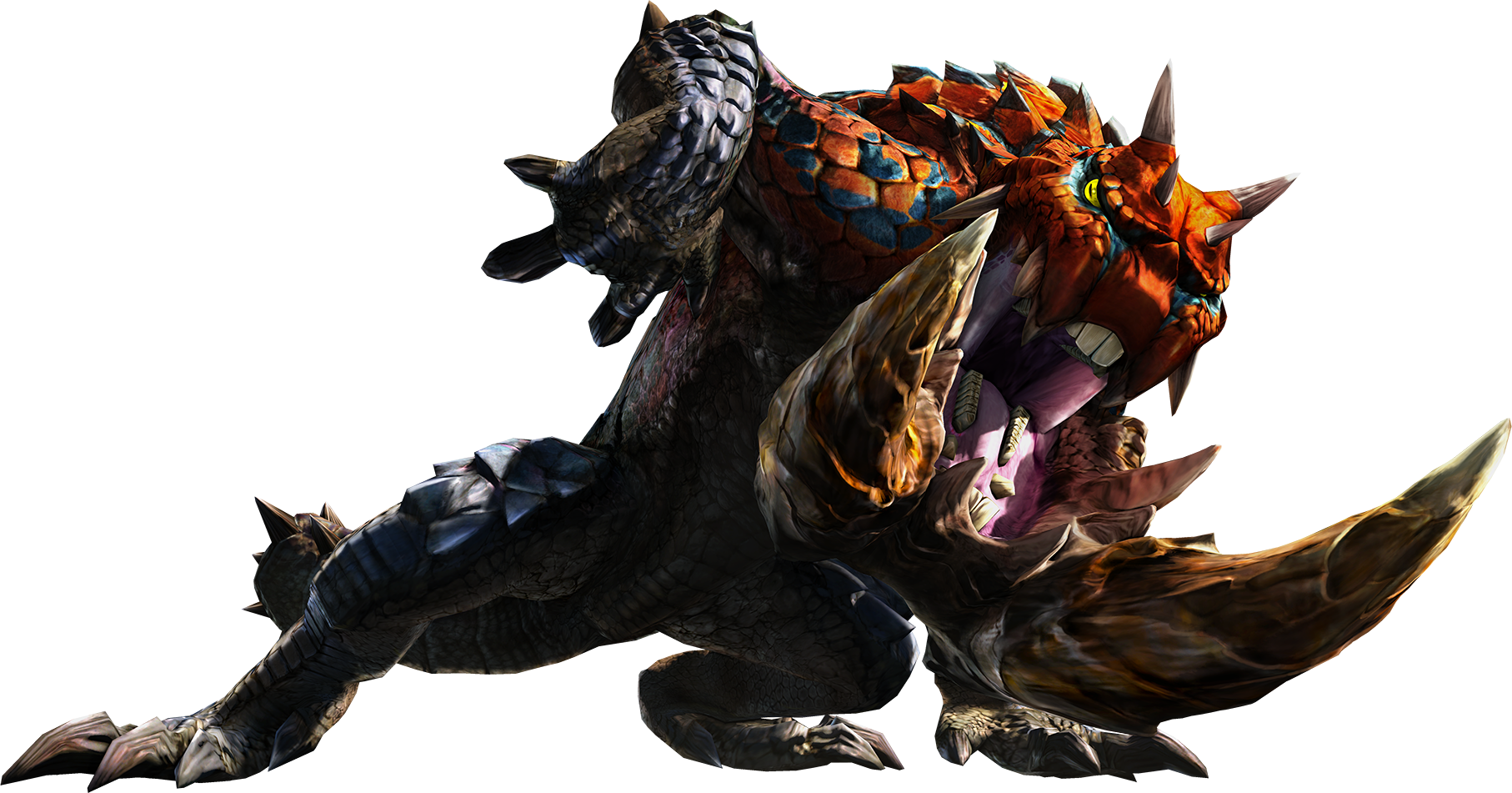
Zamite
It is a small, shark-like creature whose relatively large mouth houses many rows of teeth made for attacking prey and hunters. Zamite have been sighted in a number of different stages of development, with some having fully developed legs, while others slide on their bellies. During battle, Zamite can grow larger when it ingests bodily fluids. These fluids also allow Zamites to grow legs if they are ingested by the individuals without limbs. Zamite behave just like Giggi in the manner of aggressively attacking any possible food source and draining them of their vital fluids.
Zamite
Medium beast (amphibian), unaligned
- Armor Class 13 (natural armor)
- Hit Points 27 (5d8 + 5)
- Speed 20 ft., burrow 30 ft.
STR DEX CON INT WIS CHA 15 (+2) 12 (+1) 12 (+1) 1 (-5) 11 (+0) 4 (-3)
- Skills Stealth +3,
- Damage Immunities: Cold
- Senses darkvision 60 ft., tremorsense 60 ft., passive Perception 10
- Languages -
- Challenge 1/2 (100 xp)
Pack Tactics. The zamite has advantage on an attack roll against a creature if at least one of the zamite's allies is within 5 feet of the creature and the ally isn't incapacitated.
Actions
Bite. Melee Weapon Attack. +4 to hit, reach 5 ft., one target. Hit 5 (1d6 + 2) piercing damage.
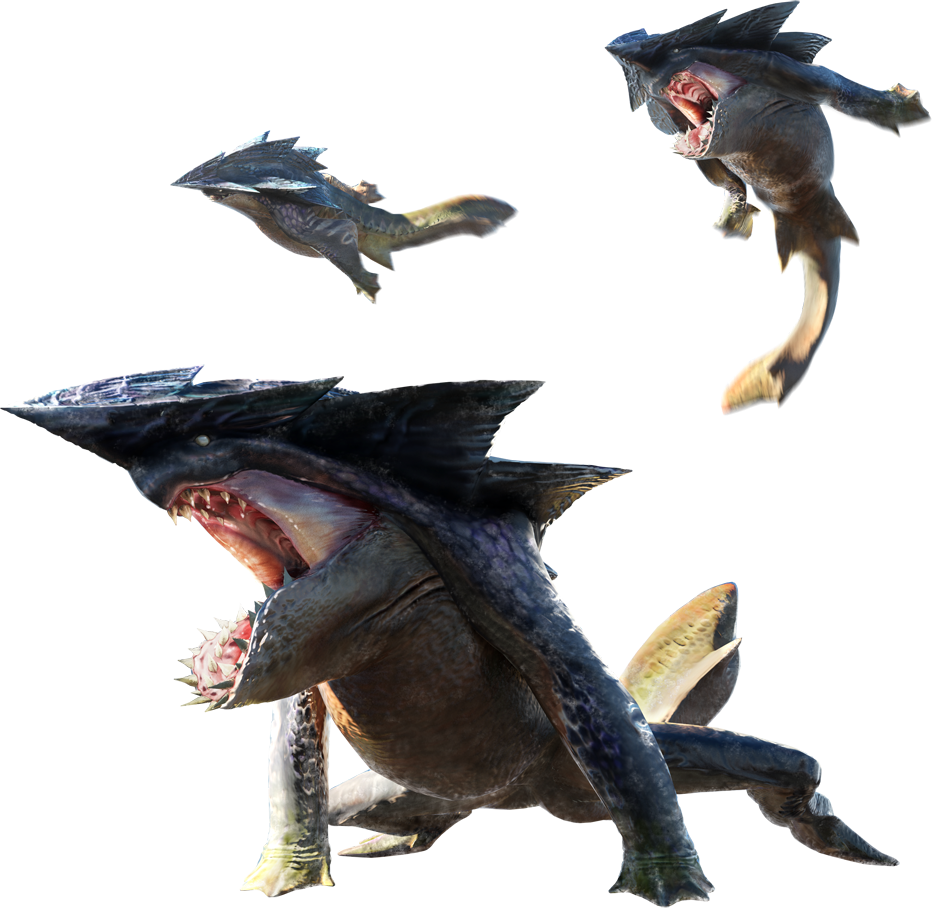
Zamtrios
Zamtrios is a large, quadrupedal monster with grey-blue skin and yellow fins. It is superficially shark-like in appearance, with a long, pointed snout and a mouth filled with multiple rows of sharp teeth. As the adult form of Zamite, its limbs are powerful and fully-developed. Its skin is extremely elastic in order to accommodate its inflation abilities.
Zamtrios is a powerful predator, but these Fanged Beasts mostly feed on plants, nuts, and mushrooms though they will sometimes eat meat. From the size of the Lagombi, it's very possible Zamtrios would try to hunt them. Though Zamtrios prefer to feed on smaller helpless prey, they are still quite dangerous in their own right. Zamtrios have even been found to feed on Plesioth in tropical waters. The massive and aggressive Gammoth can seriously injure, if not outright kill the Amphibian if confronted.
Zamtrios is a very strange Amphibian with many bizarre adaptations. Zamtrios now lacks the sharp spike its juvenile form has but now is able to produce a type of "armor". It is able to produce this armor by secreting a special fluid from its skin that eventually freezes around it forming this icy armor. This armor acts as a secondary protection against threats and also acts as weapon. When it forms this armor, it will also produce a long, rigid spike made of ice on top of its head, replacing the spike it once had, and spike on its tail as another weapon. When its not using its icy armor it will use freezing water to attack threats or prey from a distance and will spit balls of snow at them to stop their movement. Zamtrios have an under layer of skin directly under their skin used to replace previous old one. Their teeth, like saws, cut up prey just by rubbing against them.
When Zamtrios is damaged greatly while it has its icy armor, it will go through one of the most dramatic changes in nature. When greatly damaged, Zamtrios will greatly expand its body and inflate its body to several times its original body size. It goes through this change to intimidate an attacker and is able to do this from gas that it produces from inside its body. The downside to this is that Zamtrios becomes more susceptible to attacks while inflated and its maneuverability is dramatically decreased.
Zamtrios primarily spend most of their time in the water or under ice, constantly roaming around their territory and searching for prey. Like the Zamites, Zamtrios have huge appetites and have a single mind set on finding prey and to kill or eat any intruders in their territory. If Zamtrios have an enemy in their sight, they may actually chase them for miles upon miles of ice. During the breeding season Zamtrios will come together and mate. When female Zamtrios have mated they will then lay their eggs within the ice.
Zamtrios
Huge beast (amphibian), unaligned
- Armor Class 15 (natural armor)
- Hit Points 136 (13d12 + 52)
- Speed 40 ft., burrow 40 ft.
STR DEX CON INT WIS CHA 17 (+3) 12 (+1) 18 (+4) 6 (-2) 10 (+0) 5 (-2)
- Skills Perception +3, Stealth +4
- Damage Immunities: cold
- Senses darkvision 60 ft., tremorsense 60 ft., passive Perception 13
- Languages -
- Challenge 5 (1,800 xp)
Expand (2/day). The zamtrios can use a bonus action to greatly expand its belly for 1 minute. This increases its size to Gargantuan and gains resistance to bludgeoning damage. This action also remove Ice Armor if it is active. As a bonus action, the zamtrios can end this effect and revert back to its original size.
Actions
Multiattack. The zamtrios makes two bite attacks.
Bite. Melee Weapon Attack. +6 to hit, reach 10 ft., one target. Hit 16 (3d8 + 3) piercing damage.
Ice Armor. The zamtrios coats its body in ice, giving it +2 AC but -10 ft. movement for 1 minute.
Ice Drill. If the zamtrios ice armor is active and the zamtrios is underground it can then use this action to unburrow in a space occupied by another creature. The creature is pushed 5 feet out of the zamtrios space and must succeed on a DC 14 Dexterity throw or be knocked prone and take 14 (3d6+4) slashing damage plus 14 (3d6+4) piercing damage. On a successful save, the creature takes only half the damage, and isn't knocked prone.
Water Torrent (Recharge 5-6). The zamtrios shoots a beam of water from its stomach across a 30-foot cone. Each creature in that area must make a DC 14 Dexterity saving throw, taking 24 (7d6) cold damage on a failed save, or half as much damage on a successful one.
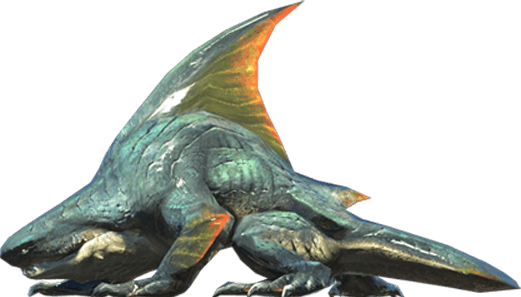
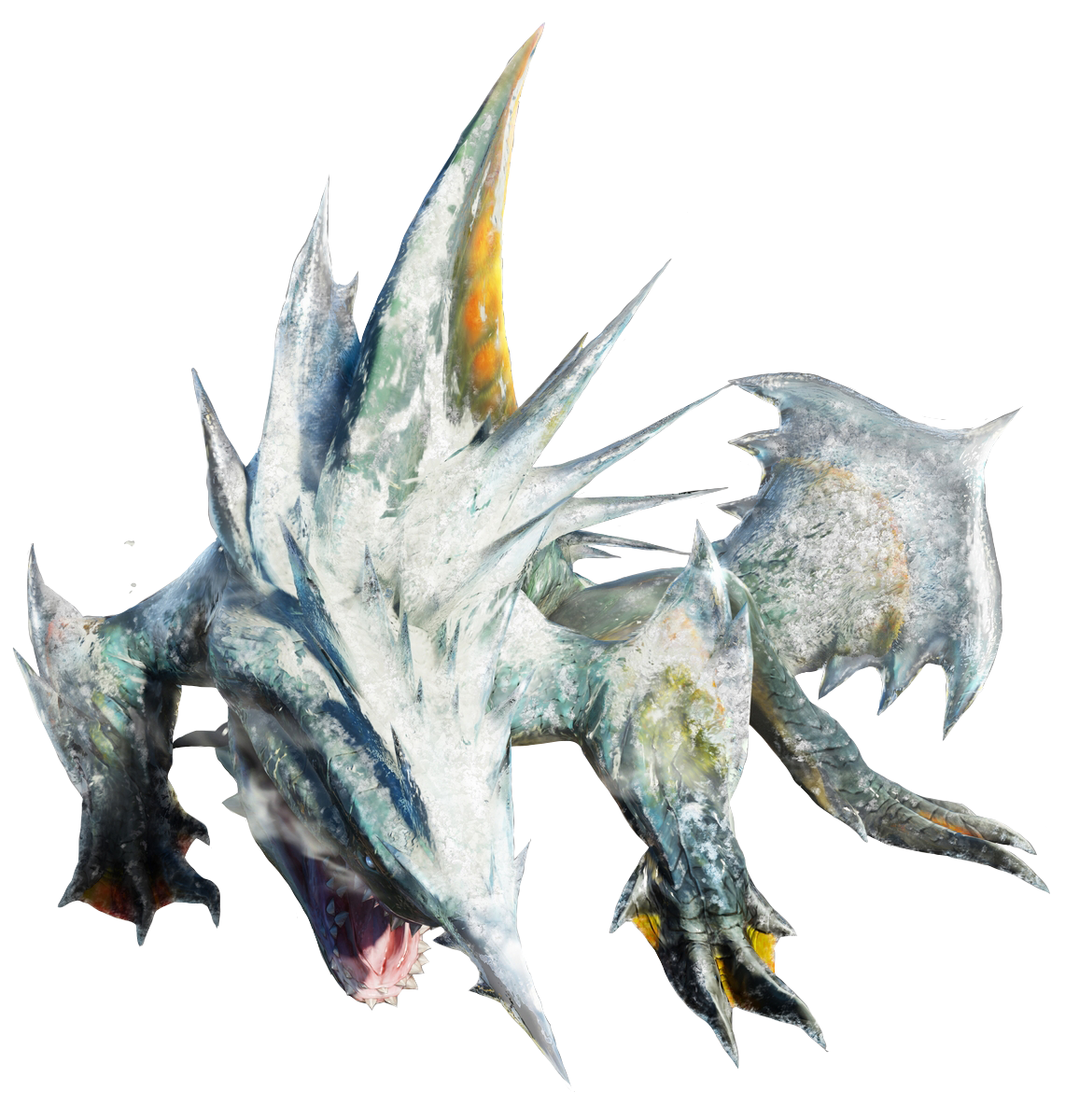
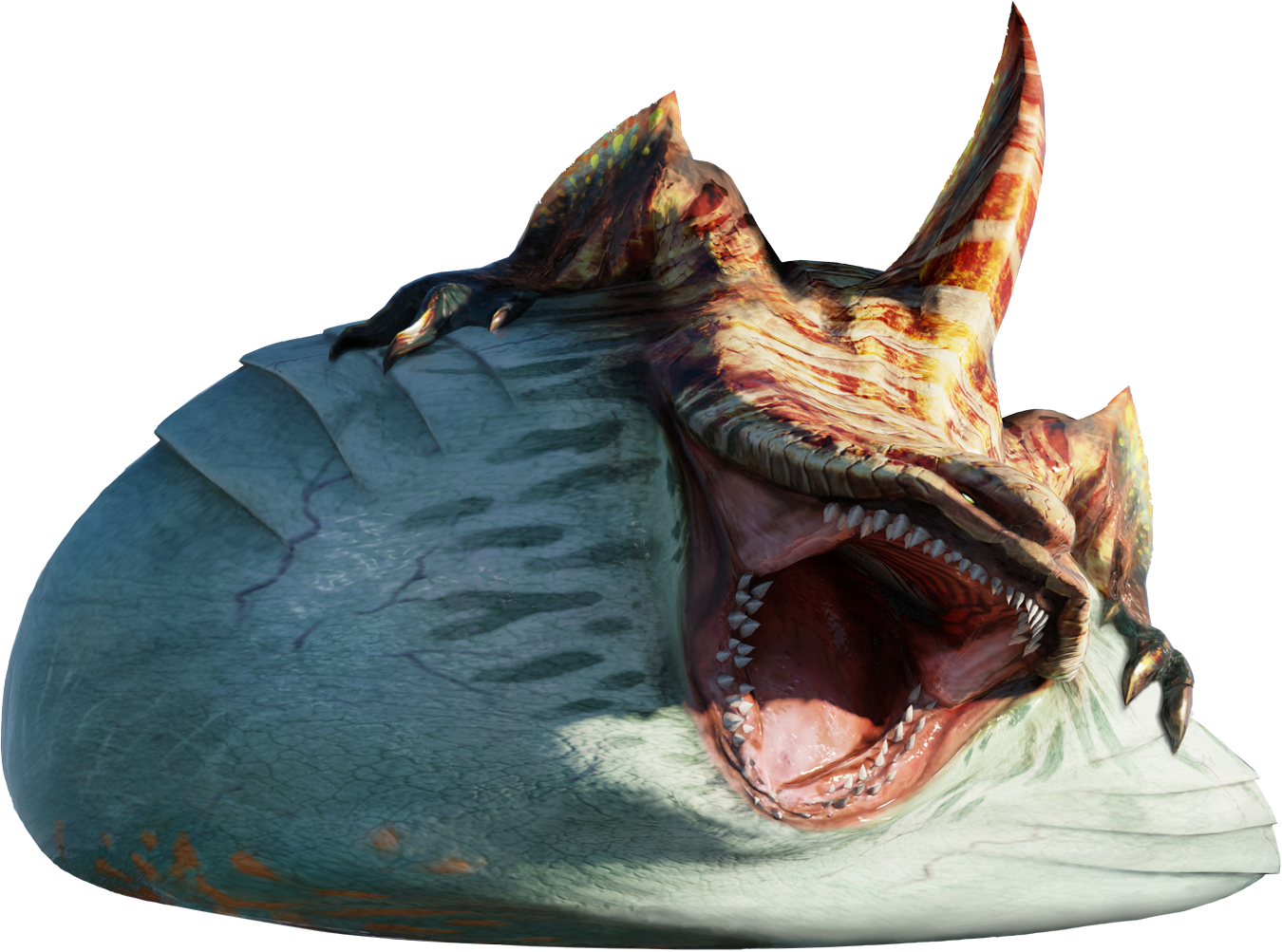
Carapaceon
Carapaceons are crustacean-like monsters that have hard shells and exoskeletons or crab-like bodies, When they're weakened by physical damage, they show internal bleeding by the frothing of the purple bubbles from their mouths. Carapaceons are known to hide underground and attack their prey once within range. Most of these crustaceans resemble crabs, lobsters or scorpions.
Hermitaur
Small beast (carapaceon), unaligned
- Armor Class 14 (natural armor)
- Hit Points 49 (9d6 + 18)
- Speed 30 ft., burrow 20 ft.
STR DEX CON INT WIS CHA 15 (+2) 13 (+1) 14 (+2) 6 (-2) 10 (+0) 9 (-1)
- Senses darkvision 60 ft., tremorsense 60 ft., passive Perception 10
- Languages -
- Challenge 1/2 (100 xp)
Scuttle. As a bonus action, the hermitaur can moves up to its half speed in a straight line.
Actions
Claws. Melee Weapon Attack: +4 to hit, reach 5 ft., one target. Hit 5 (1d6 + 2) slashing damage.
Water Beam. Range Weapon Attack. +4 to hit, reach 30/120 ft., one target. Hit 6 (1d8 + 2) cold damage. On a hit, the target must make a DC 12 Constitution saving throw or become poisoned with waterblight.
Reactions
Retreat. After being hit by an attack, the hermitaur can take the dodge action until the start of its next turn by retreating into its shell and using its shield-like claws to protect its head.
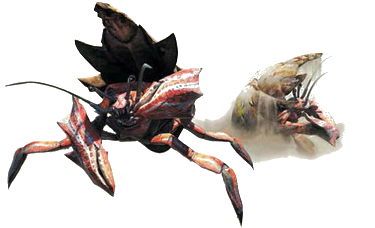
Hermitaur
Hermitaur are hermit crab-like monsters with red carapaces and a thick white shell. The shell is grown by the crab itself; only when they grow much larger, into a Daimyo Hermitaur, will they replace it with a Monoblos skull, or into a Diablos skull. Hermitaurs are related to the Ceanataur, a blue Carapaceon that lives in Volcanic regions.
When they are left undisturbed, Hermitaurs are most often seen picking through sand with their claws, presumably searching for food. Sometimes, a Hermitaur may wait beneath the ground for prey or a hunter to pass, jumping out of the ground and striking them when they walk overhead. A Hermitaur that is burrowed underground can be spotted by the puffs of dust that it regularly spits out.
Daimyo Hermitaur
Daimyo Hermitaur has a large, crab-like body. It is covered in a red and white carapace and wears the skull of a Monoblos as a protective shell. They have huge, thick claws capable of holding prey as well as shielding the giant crab from most any attacks. Daimyo Hermitaur's shell is also very tough, able to deflect the blows of most weapons. The one chink in the creature's armor is its soft hindquarters, where many of the creature's major organs are stored. To fix this problem, Daimyo Hermitaur will wear the skulls of dead wyverns on their backs. Acquiring the right size shell is a chore though, and occasionally Daimyo Hermitaur can be spotted with shells too large, or small for their bodies. Almost all of Daimyo Hermitaur's shells come from members of the larger species like Monoblos. Daimyo Hermitaur also possess surprisingly strong legs, able to move the creature with great speed if necessary. The legs assist the creature in digging holes and they are able to launch themselves many feet into the air, causing them to land vigorously on top of hunters who don't react fast enough.
Some unusual rare Daimyo Hermitaur have a dark reddish color on their claws, darker legs and more shiny eyes. Along with this their shells are unusually covered in moss or algae. They also have the ability to spit long streams of water. They use new attack techniques as their claws are much stronger than average, they use their claws in a shielded position much like a human boxing while walking at a target, these claws are reported to be so strong in this position that ranged projectiles fired from guns ricochet, along with this new smarter advancing technique they perform a very aggressive non stop side to side claw snapping attack behavior that out-speeds most attackers.
Despite their size, Daimyo Hermitaur are fairly calm, when undisturbed. However, Daimyo Hermitaur will turn aggressive if they feel threatened or attacked. Most of time, they can be seen foraging for food as they roam around their environment.
Daimyo Hermitaur
Huge beast (carapaceon), unaligned
- Armor Class 19 (natural armor)
- Hit Points 168 (16d12 + 64)
- Speed 30 ft., burrow 20 ft.
STR DEX CON INT WIS CHA 18 (+4) 16 (+3) 18 (+4) 13 (+1) 14 (+2) 16 (+3)
- Damage Resistances piercing, slashing
- Damage Vulnerabilities lightning
- Senses darkvision 60 ft., tremorsense 60 ft., passive Perception 12
- Languages -
- Challenge 9 (5,000 xp)
Scuttle. As a bonus action, the daimyo hermitaur can moves up to its speed in a straight line.
Actions
Multiattack. The daimyo hermitaur makes two claw attacks.
Claws. Melee Weapon Attack: +8 to hit, reach 5 ft., one target. Hit 20 (3d10 + 4) slashing damage.
Water Beam. Range Weapon Attack. +8 to hit, reach 30/120 ft., one target. Hit 22 (4d8 + 4) cold damage. On a hit, the target must make a DC 16 Constitution saving throw or become poisoned with waterblight.
Crush (Recharge 5-6). If the daimyo hermitaur jumps at least 15 feet as part of its movement, it can then use this action to land on its feet in a space that contains one or more other creatures. Each of those creatures must succeed on a DC 18 Strength or Dexterity saving throw (target's choice) or be knocked prone and take 22 (4d8 + 4) bludgeoning damage. On a successful save, the creature takes only half the damage, isn't knocked prone, and is pushed 5 feet out of the daimyo hermitaur's space into an unoccupied space of the creature's choice. If no unoccupied space is with in range, the creature instead falls prone in the daimyo hermitaur's space.
Reactions
Retreat. After being hit by an attack, the daimyo hermitaur can take the dodge action until the start of its next turn by retreating into its shell and using its shield-like claws to protect its head.
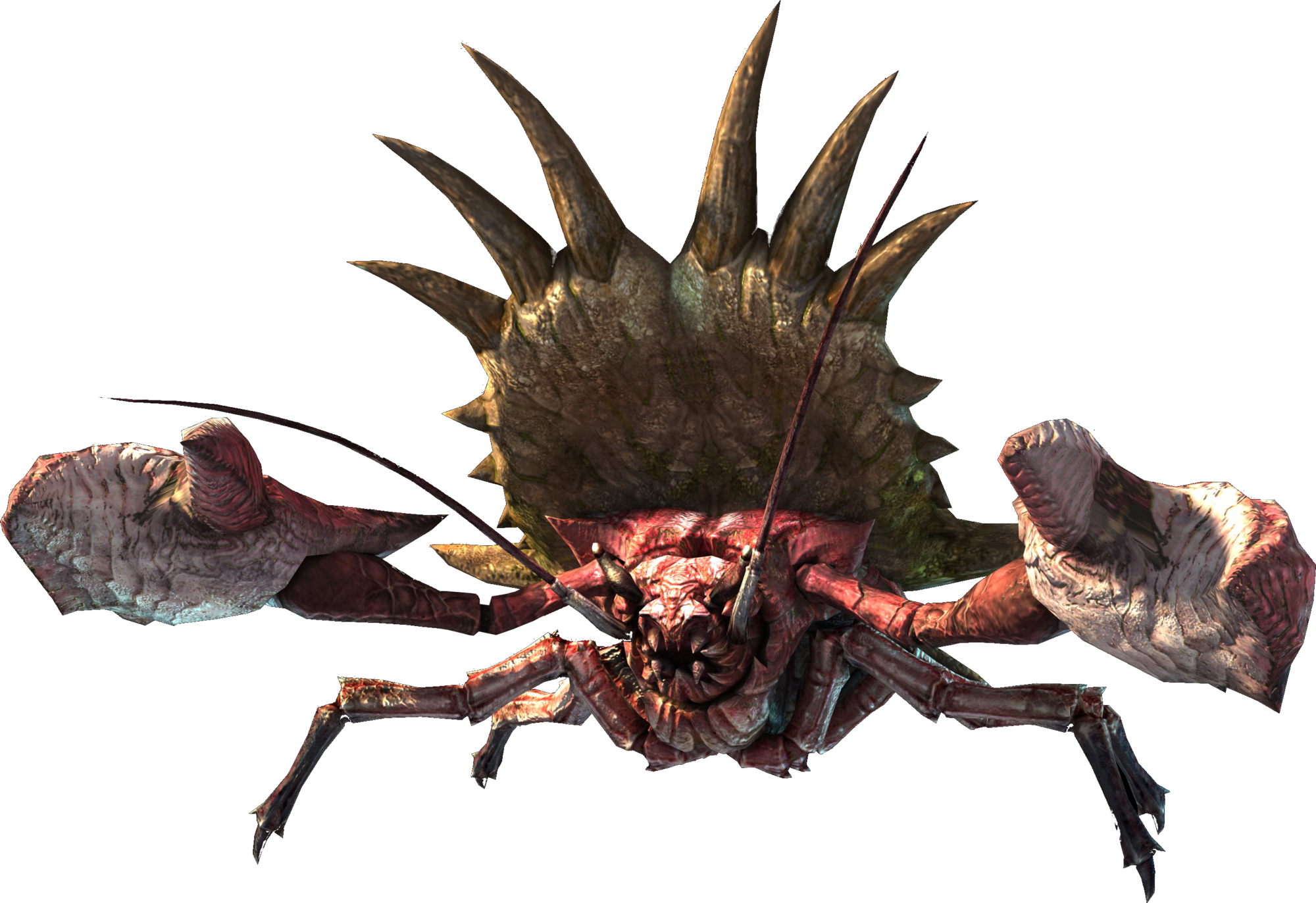
Ceanataur
Small beast (carapaceon), unaligned
- Armor Class 14 (natural armor)
- Hit Points 44 (8d6 + 16)
- Speed 30 ft., burrow 20 ft.
STR DEX CON INT WIS CHA 15 (+2) 13 (+1) 14 (+2) 5 (-2) 10 (+0) 9 (-1)
- Senses darkvision 60 ft., tremorsense 60 ft., passive Perception 10
- Languages -
- Challenge 1/2 (100 xp)
Scuttle. As a bonus action, the ceanataur can moves up to its half speed in a straight line.
Actions
Claws. Melee Weapon Attack: +4 to hit, reach 5 ft., one target. Hit 6 (1d8 + 2) slashing damage. If the target is a creature other than an undead or a construct, it must succeed on a DC 10 Constitution saving throw or lose 2 (1d4) hit points at the start of each of its turns due to an bloody wound. Each time the ceanataur hits the wounded target with this attack, the damage dealt by the wound increases by 2 (1d4). Any creature can take an action to stanch the wound with a successful DC 10 Wisdom (Medicine) check. The wound also closes if the target receives magical healing.
Poison Spit. Range Weapon Attack. +4 to hit, reach 30/120 ft., one target. Hit 5 (2d4) poison damage. On a hit, the target must make a DC 10 Constitution saving throw or become poisoned. The target can repeat the saving throw at the end of each of its turns , ending the effect on itself on a success.
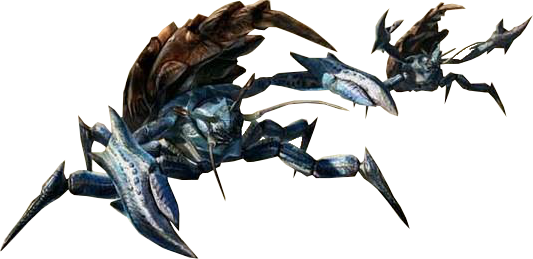
Ceanataur
Similar in appearance to the Hermitaur with sharper claws, leg stubs and a higher-edge shell. The shell on its back was actually grown by the Ceanataur itself. Only when it grows much larger into a Shogun Ceanataur will it replace its shell with a larger monsters skull, like a Gravios skull.
It is able to spit a small ball of poisonous fluid at foes. Sometimes, a Ceanataur may wait beneath the ground for prey or a hunter to pass, jumping out of the ground and striking them when they walk over. A Ceanataur that's burrowed underground can be spotted by the puffs of dust that it regularly spits out.
Ceanataur are very aggressive towards anything that threatens. They are well-known for chasing adventurers down in order to attack them. While young, Ceanataur are quite low in the food chain. They are known to feed on smaller species and anything else they can get their claws on. Ceanataur will even attempt to feed humans.
Shogun Ceanataur
Shogun Ceanataur is a Carapaceon. However, they hardly resemble their cousins, the Daimyo Hermitaur. Shogun Ceanataur's body is covered in a blue carapace. Its head is long and knife-shaped, and features a pair of lengthy antennae. Its folding claws act as sickles, that fully extended, adding a significant amount of range to its reach. Shogun Ceanataur is known to inhabit a variety of shells, among them: A Gravios skull, a snail-like shell, and a skull belonging to an unknown wyvern.
Compared to Daimyo Hermitaur, Shogun Ceanataur has a much slimmer shape. From the lighter shell of Shogun Ceanataur, it is able to move faster than Daimyo Hermitaur. With this lighter armor, Shogun Ceanataur are also able to attack and move offensively rather than defensively. Another bizarre defense of Shogun Ceanataur is its own urine. While wearing a skull and hanging on a ceiling, Shogun Ceanataur are known to spray water on their enemies from the ceiling.
Each Shogun Ceanataur has their own personality. Some are more aggressive than others. When undisturbed, Shogun Ceanataur are usually fairly calm, however, if threatened, they will turn aggressive in an instant. They’ll unsheathe their claws and will attempt to kill a foe. If the skull on Shogun Ceanataur's backside is broken, it'll immediately go looking for another one, so it can protect its vulnerable bottom.
Shogun Ceanataur are somewhat high in the food chain. They primarily feed on small creatures that live in dark environments like shrimp and insects, but will also feed on carrion. Despite this, they can more than hold their own against larger species. They are also known to have battles with Khezu and other Shogun Ceanataur in the caves of the swamp.
Shogun Ceanataur
Huge beast (carapaceon), unaligned
- Armor Class 17 (natural armor)
- Hit Points 157 (15d12 + 60)
- Speed 40 ft., burrow 30 ft., climb 30 ft.
STR DEX CON INT WIS CHA 19 (+4) 16 (+3) 18 (+4) 14 (+2) 14 (+2) 16 (+3)
- Saving Throws Dex +8, Con +9, Wis +7
- Damage Resistances cold; bludgeoning, piercing, and slashing from nonmagical weapons
- Senses darkvision 60 ft., tremorsense 60 ft., passive Perception 12
- Languages -
- Challenge 13 (10,000 xp)
Scuttle. As a bonus action, the shogun ceanataur can moves up to its speed in a straight line.
Actions
Multiattack. The shogun ceanataur makes two claw attacks. It can use Poison Spit in place of any melee attack.
Hydropump (recharge 5-6). The shogun ceanataur releases a high pressure stream of water from the back of its shell in an 60-foot line that is 5 feet wide. Each creature in that line must make a DC 17 Dexterity saving throw, taking 44 (8d10) cold damage on a failed save, or half as much damage and not on a successful one.
Claws. Melee Weapon Attack: +9 to hit, reach 10 ft., one target. Hit 20 (3d10 + 4) slashing damage. If the target is a creature other than an undead or a construct, it must succeed on a DC 16 Constitution saving throw or lose 3 (1d6) hit points at the start of each of its turns due to an bloody wound. Each time the shogun ceanataur hits the wounded target with this attack, the damage dealt by the wound increases by 3 (1d6). Any creature can take an action to stanch the wound with a successful DC 14 Wisdom (Medicine) check. The wound also closes if the target receives magical healing.
Poison Spit. Range Weapon Attack. +9 to hit, reach 30/120 ft., one target. Hit 17 (7d4) poison damage. On a hit, the target must make a DC 17 Constitution saving throw or become poisoned for 1 minute. The target can repeat the saving throw at the end of each of its turns , ending the effect on itself on a success.
Legendary Actions
The shogun ceanataur can take 3 legendary actions, choosing from the options below. Only one legendary action option can be used at a time and only at the end of another creatures turn. The shogun ceanataur regains spent legendary actions at the start of its turn.
Dig. The shogun ceanataur burrows underground and moves up to half its burrow speed.
Spit. The shogun ceanataur makes a Poison Spit attack.
Sweeping Strike (Costs 2 Actions). The shogun ceanataur sweeps its claws in a 10 ft. line that is 35ft. wide. Each creature in the area must make a DC 16 Dexterity saving throw, taking 11(2d10) slashing damage and increases the damage from a bloody wound by 3 (1d6) on a failed save. On a successful one, the target takes half damage and does not increase the bloody wounds damage.
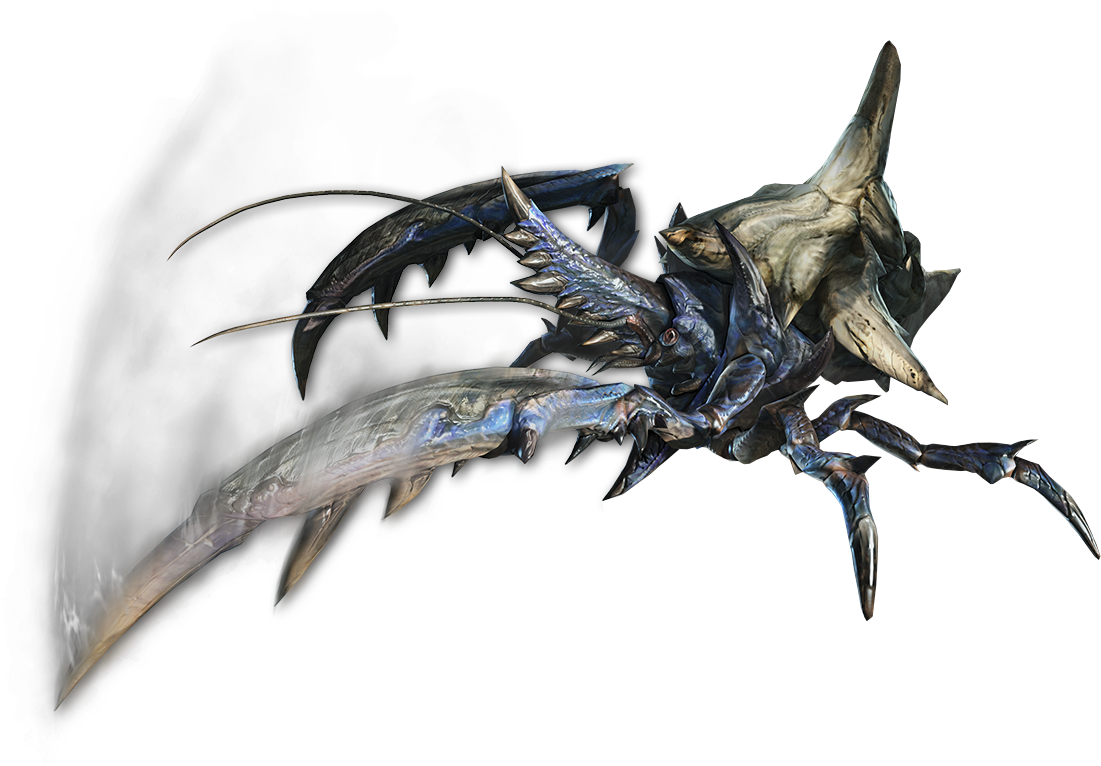
Shen Gaoren
Identifiable by their grey skin, towering legs and the gigantic green-yellow balls of acid that they generate and hurl from the rear of their bodies. Shen Gaoren are so large they use a Lao-Shan Lung skull for protection. Their colossal size helps them to defeat most creatures. The diet of Shen Gaoren is unknown; however, it is likely to be omnivorous, like most real-life crabs.
Its massive pincers are incredibly strong and sturdy, being described as capable of cutting through even the toughest volcanic rock. Its long legs give the Shen Gaoren an incredible field-of-vision, and if its eyesight is proficient, it should be able to spot prey from a very large distance. Like many other Carapaceons, its rear section is naturally very soft, and, if left unprotected, it's a large weak point. Fortunately, for them, Shen Gaoren are able to acquire the equally gigantic skull shells of the mighty Lao-Shan Lung, whether they are actually able to kill the massive dragon is still uncertain, but unprobable, which serves as incredibly efficient armor. It has been recently found that the gigantic skull shows signs of containing the deadly dragon element but Shen Gaoren doesn't seem to use the this element. The Shen Gaoren is grey/blue in color, but its legs turn red as they experience great pain.
One of Shen Gaoren's deadliest abilities is its ability to shoot a gigantic ball of acid from its gigantic skull. This acidic ball can corrode armor rather quickly and, in some cases, it can even melt straight through the armor. It's unknown how this monster is able to produce this acid or even fire it out of its skull.
Due to Shen Gaoren not being seen interacting with other species, it is unknown how it fits into the ecological niche. Shen Gaoren are relatively passive by nature. They move about without noticing hunters; however, when enraged, it may attempt to attack hunters by using their huge sturdy claws or by moving their legs and pincers wildly. It was recently discovered that Shen Gaoren attack villages and cities because they are in its territory. Shen Gaoren were found to attack any foe that pose any threat to them, showing that these passive giants can be aggressive when they feel that their life is in danger. When Shen Gaoren get old enough, or injured in battle, they'll molt.
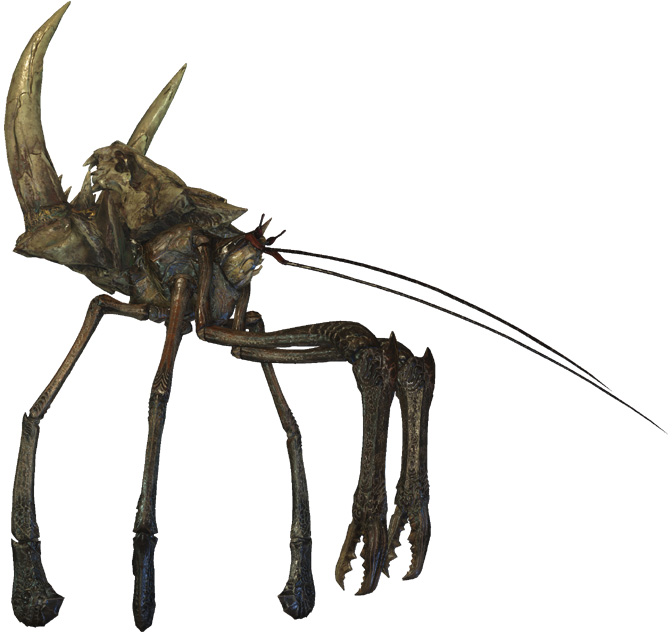
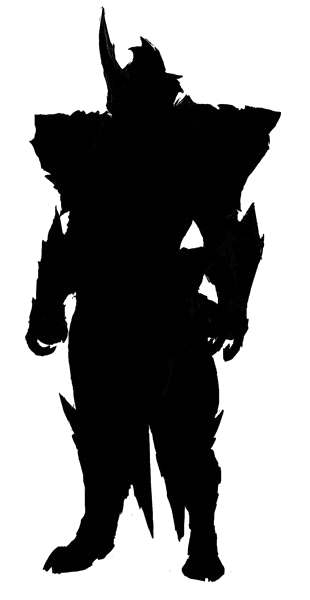
Shen Gaoren
Gargantuan monstrosity (carapaceon), unaligned
- Armor Class 25 (natural armor)
- Hit Points 430 (21d20 + 210)
- Speed 40 ft., burrow 30 ft., climb 30 ft.
STR DEX CON INT WIS CHA 30 (+10) 10 (+0) 30 (+10) 5 (-3) 14 (+2) 9 (-1)
- Saving Throws Int +6, Wis +11 Cha +8
- Skills Perception +11
- Damage Immunities cold, poison; bludgeoning, piercing, and slashing from nonmagical weapons
- Damage Resistances acid, fire, thunder; (bludgeoning, piercing, and slashing from magical weapons while lao-shun skull is not broken)
- Condition Immunities charmed, frightened, paralyzed, poisoned
- Senses blindsight 120 ft., passive Perception 21
- Languages -
- Challenge 30 (155,000 xp)
Legendary Resistance (3/Day). If the shen gaoren fails a saving throw, it can choose to succeed instead.
Magic Resistance. The shen gaoren has advantage on saving throws against spells and other magical effects.
Siege Monster. The shen gaoren deals double damage to objects and structures.
Lao-Shun Skull. The shen gaoren protects its vulnerable back with the skull of a Lao Shun (AC 20, 200 HP; immunity to poison and psychic damage, resistances to piercing, and slashing from nonmagical weapons, vulnerable to bludgeoning damage). Damaging the shell deals no damage to the shen gaoren. Once destroyed, the shen gaoren takes -2 to AC and becomes vulnerable to bludgeoning, piercing, and slashing from magical weapons.
Armored Legs. The shen gaoren has 4 legs stretching 30 feet up. Each leg can be attacked (AC 16; 25 hit points; immunity to poison and psychic damage, resistances to bludgeoning, piercing, and slashing from nonmagical weapons). Damaging a leg deals no damage to the shen gaoren. Reducing all four legs to 0 hit points causes the shen gaoren to immediately use its reaction to collapse. 3 rounds after the shen gaoren uses collapse, its legs heal to their maximum hp and the shen gaoren can stand up.
Actions
Summon Hermitaurs. The shen gaoren summons 5 (1d10) hermitaurs from underground within 120 feet of the shen gaoren.
Multiattack. The shen gaoren can use its Summon Hermitaurs. It then makes six attacks: four with its legs and two with its claw attack. It can replace any of these attacks with a Acid Spit attack, so long as the Lao Shun Shell is not destroyed.
Claws. Melee Weapon Attack: +19 to hit, reach 15 ft., one target. Hit 24 (4d6 + 10) slashing damage. If the target is a creature, it is grappled (escape DC 20) . Until this grapple ends, the target is restrained. The shen gaoren can grapple up to 2 targets, one with each claw.
Legs. Melee Weapon Attack: +19 to hit, reach 10 ft. while standing or 5 ft. while prone, one target. Hit 28 (4d8 + 10) slashing damage. If the target is a creature, it must make a DC 20 Strength saving throw or be pushed back 10 feet and knocked prone.
Acid Spit (usable only when standing). Range Weapon Attack. +19 to hit, reach 30/120 ft., one target. Hit 24 (4d6 + 10) acid damage. If the creature is in either metal armor or has a metal shield being worn or carried, its takes a permanent and cumulative -1 penalty to the AC it offers. Armor reduced to an AC of 10 or a shield that drops to a +0 bonus is destroyed. If the creature has a nonmagical weapon made of metal, the weapon takes a permanent and cumulative -1 penalty to damage rolls. If its penalty drops to -5, the weapon is destroyed.
Collapse. The shen gaoren falls prone for 3 rounds crushing any creature under or around it. While prone in this way, the shen gaoren may still move up to half its movement speed and creatures do not gain advantage on melee weapon attack against the shen gaoren. Any creatures under or within 5 feet of the shen gaoren must succeed on a DC 20 Strength or Dexterity saving throw (target's choice) or be knocked prone and take 28 (4d8 + 10) bludgeoning damage. On a successful save, the creature takes only half the damage, isn't knocked prone, and is pushed 5 feet out of the shen gaoren's space into an unoccupied space of the creature's choice. If no unoccupied space is with in range, the creature instead falls prone in the shen gaoren's space.
Acid Spray (recharge 5-6, only usable while prone and Lao Shun Skull is not destroyed). The shen gaoren releases a high pressure stream of poison from its shell and turns 360 degrees around. Each creature, on the ground, in a 30-foot radius of shen gaoren must make a DC 17 Dexterity saving throw, taking 99 (18d10) acid damage on a failed save, or half as much damage and not on a successful one.
Legendary Actions
The shen gaoren can take 3 legendary actions, choosing from the options below. Only one legendary action option can be used at a time and only at the end of another creatures turn. The shen gaoren regains spent legendary actions at the start of its turn.
Move. The shen gaoren moves up to half its speed.
Attack. The shen gaoren makes one Claw or Leg attack.
Shake Off (Costs 2 Actions). The shen gaoren thrashes around in an attempt to throw any object or creature that is on its body. Each creature on the shen gaoren must make a DC 20 Strength or Dexterity saving throw (creature's choice), or be thrown off the shen gaoren taking 21 (6d6) fall damage upon hitting the ground.
Piscine Wyverns
The term 'Piscine' is applied to creatures that are known to swim or glide in preference to walking on solid ground. The body structure of a Piscine usually resembles that of a fish, with lesser evolved legs in comparison to most other monster species. Piscines include the sand-dwelling creatures, which can be found throughout the desert. Monsters found commonly in the waters and one which dwells in magma, and can be found in the volcanic areas. Piscines are also known as Wyverns, due to their similar structure and ability of flight. All Piscines have two Limbs that enable them to walk on land, and a selection of Fins to help them swim through their chosen habitat. Many of their "wings" have evolved into fins.
Cephalos
Cephalos' body shapes are streamlined and flat, to help them swim through the sand. They have a vaguely hammer-shaped head, with eyes that face upwards. Their brown and beige coloration helps them camouflage themselves among the desert sands. These monsters are surprisingly social, swimming through the loose sand and hunting in packs. They are predatory, and can work together to defeat creatures many times their size.
From spending large amounts of time swimming in the sand, their eyesight has become very poor and now they are nearly blind. Instead Cephalos listen for not only for the footsteps of prey but, also for the breathing of prey. If the sounds are extremely loud, they will be shocked out the ground and stunned by the loud noise. To stay cool in the heat of the desert, its scales hold large amounts of moisture in its body, allowing for more activity in its environment. They can't breath in the sand so they have to occasionally jump out the sand in order to breath air. While swimming, however, they will swallow some of the sand as they swim. The swallowed sand is stored in a special organ in their body, that combines sand with its mucus, and saves this sand as a weapon to injure prey.
The true color of a Cephalos is blue, or rarely purple, but over time sand sticks to their bodies covering the blue coloration. Mildly aggressive, Cephalos are known for gathering in packs and hunt alongside their leaders, Cephadrome. They are also known for migrating to different parts of the desert when food sources are drained.
Cephalos
Large wyvern (piscine), unaligned
- Armor Class 11 (natural armor)
- Hit Points 52 (7d10 + 14)
- Speed 20 ft., burrow 30 ft.
STR DEX CON INT WIS CHA 18 (+4) 12 (+1) 15 (+2) 7 (-2) 9 (-1) 5 (-3)
- Skills Perception +1
- Senses passive Perception 11
- Languages -
- Challenge 2 (450 xp)
Sensitive Ears. While underground the cephalos ears are very sensitive, Thunder skills or spells used within 60 feet force the cephalos to use its reaction to move towards the surface. If it reaches the surface while still having movement left, it launches into the air and lands prone on the ground.
Keen Hearing. The cephalos has advantage on Wisdom (Perception) checks that rely on hearing.
Actions
Hip Check. Melee Weapon Attack: +6 to hit, reach 5 ft., one target. Hit 13 (2d8 + 4) bludgeoning damage.
Tail. Melee Weapon Attack. +6 to hit, reach 10 ft., one target. Hit 15 (2d10 + 4) bludgeoning damage.
Sand Blast. Range Weapon Attack. +6 to hit, reach 30/120 ft., one target. Hit 11 (2d6 + 4) bludgeoning damage.
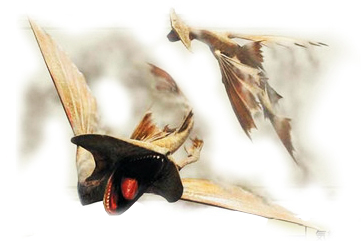
Cephadrome
Cephadrome have yellow eyes, yellow or pink fins and blue or purple scale covered skin. This skin appears brownish black due to sand covering their body. They have a flat, diamond-shaped head (much like a hammerhead shark or a Diplocaulus, an extinct prehistoric amphibian), fins, and tail, which helps propel them through the sand.
Cephadrome are very aggressive, however, it will assume evasive maneuvers if it senses that the threat is too dangerous. Cephadrome swims in sand to avoid danger, then attacks unexpectedly to startle its foe. It also uses a sand "spray" to attack from a distance. A leader its role may be as a main attacker. A Cephadrome is also very protective of the Cephalos in its pack. They will attack larger predators or even the aggressive Diablos to distract the foe away from its pack.
Interestingly, the life of these creatures begins in water. The females will lay their eggs in an oasis and those eggs will hatch during the dry season. After the offspring hatch they will swim in the mud and as it dries it will become much tougher for the hatchlings to swim in. When the mud begins to turn into sand the hatchlings will slowly learn to swim through the sands of the desert and it is very important that they do so.
Cephadrome
Huge wyvern (piscine), unaligned
- Armor Class 16 (natural armor)
- Hit Points 175 (14d12 + 84)
- Speed 30 ft., burrow 40 ft.
STR DEX CON INT WIS CHA 20 (+5) 12 (+1) 23 (+6) 9 (-1) 10 (+0) 7 (-2)
- Skills Perception +3
- Senses passive Perception 13
- Languages -
- Challenge 7 (2,900 xp)
Sensitive Ears. While underground the cephadrome ears are very sensitive, Thunder skills or spells used within 60 feet force the cephadrome to use its reaction to move towards the surface. If it reaches the surface while still having movement left, it launches into the air and lands prone on the ground.
Keen Hearing. The cephadrome has advantage on Wisdom (Perception) checks that rely on hearing.
Actions
Multiattack. The cephadrome makes one hipcheck attack and one tail attack; or it makes two sand blast attacks.
Hip Check. Melee Weapon Attack: +8 to hit, reach 5 ft., one target. Hit 18 (3d8 + 5) bludgeoning damage.
Tail. Melee Weapon Attack. +8 to hit, reach 10 ft., one target. Hit 21 (3d10 + 5) bludgeoning damage.
Sand Blast. Range Weapon Attack. +8 to hit, reach 30/120 ft., one target. Hit 15 (3d6 + 5) bludgeoning damage.
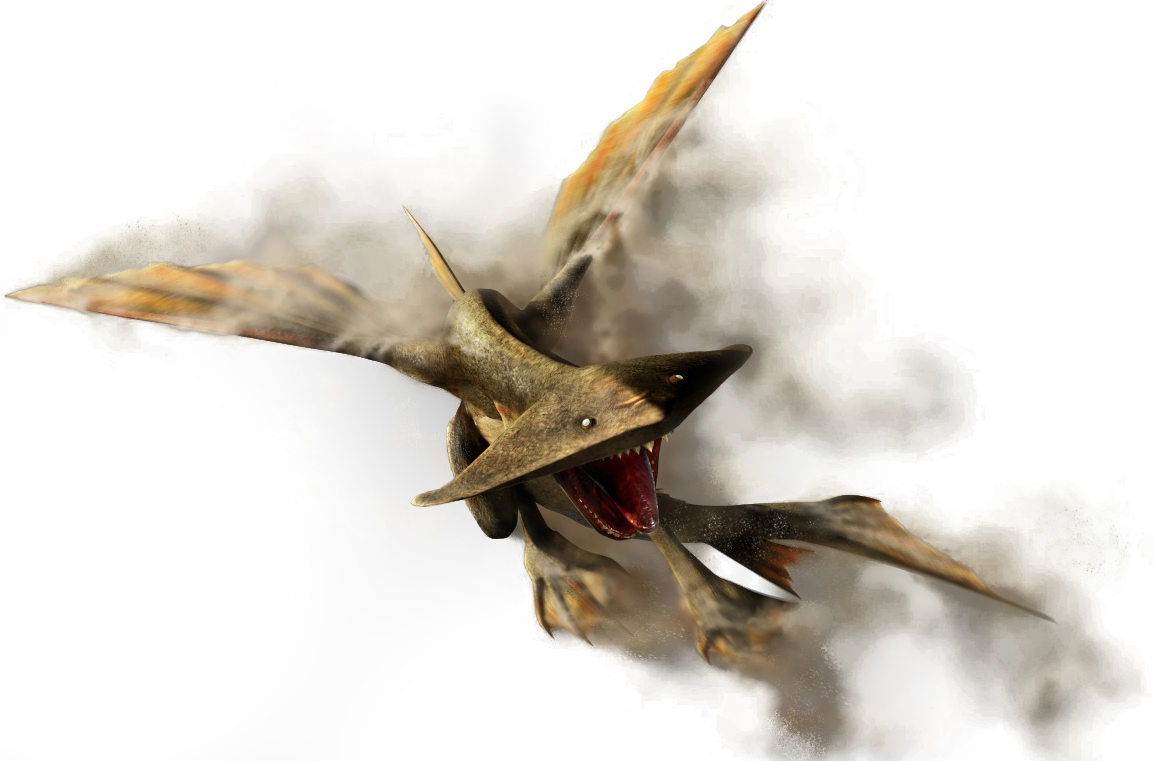
Delex
They have, like the Cephalos, the ability to "swim" through sand and even expel small sand blasts from their mouth at attackers. Due to their nimbleness they are difficult to hit. Several appear in the fights with Jhen Mohran and Dah'ren Mohran, jumping onto the boat and attacking Hunters that get in their way. Delex hunt in small groups of six or seven individuals and likely prey upon small animals. They also scavenge off the remains left by larger desert-dwelling monsters.
Delex
Small wyvern (piscine), unaligned
- Armor Class 9 (natural armor)
- Hit Points 22 (5d6 + 5)
- Speed 40 ft., burrow 40 ft.
STR DEX CON INT WIS CHA 11 (+0) 13 (+1) 12 (+1) 1 (-5) 8 (-1) 10 (+0)
- Senses tremorsense 60 ft., passive Perception 9
- Languages -
- Challenge 1/8 (25 xp)
Tunnel. The delex doesn't provoke an opportunity attack when it burrows out of an enemy's reach.
Actions
Bite. Melee Weapon Attack: +2 to hit, reach 5 ft., one target. Hit 3 (1d6) piercing damage.
Sand Blast. Range Weapon Attack. +3 to hit, reach 30/120 ft., one target. Hit 4 (1d6 + 1) bludgeoning damage.
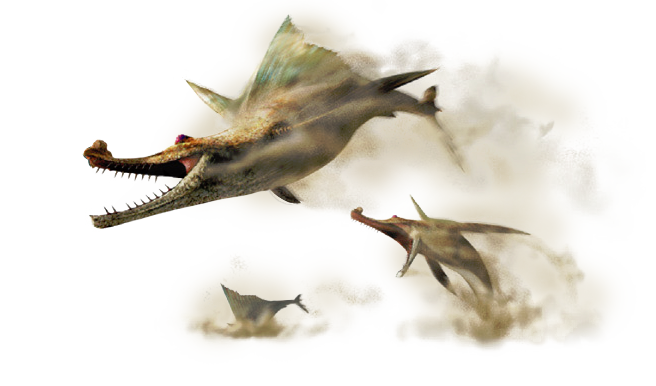
Gajau
Gajau have greenish scales with orange dorsal fins. They resemble catfish in appearance. Gajau are vicious predatory fish that will attack anything. Gajau will even jump out of the water to capture prey.
Gajau
Small wyvern (piscine), unaligned
- Armor Class 11 (natural armor)
- Hit Points 27 (6d6 + 6)
- Speed 0 ft., swim 30 ft.
STR DEX CON INT WIS CHA 14 (+2) 13 (+1) 12 (+1) 1 (-5) 10 (+0) 8 (-1)
- Senses darkvision 60 ft., passive Perception 10
- Languages -
- Challenge 1 (200 xp)
Blood Frenzy. The gajau has advantage on melee attack rolls against any creature that doesn't have all its hit points.
Actions
Bite. Melee Weapon Attack: +4 to hit, reach 5 ft., one target. Hit 6 (1d8 + 2) piercing damage.

Plesioth
Plesioth are bipedal monsters with a wyvern-esque body structure. They have webbed feet and a paddle-like tail, and are covered in shiny, fish-like scales. Their mouth is filled with shark-like teeth, and their eyes glow a bright yellow. Their head and back feature large fins which can fold in and out at will.
Plesioth do not possess gills for breathing underwater, so they have to come up for air every so often to fill their lungs with air. In addition to having lungs these creatures can also breath through their skin like an amphibian or sea snake. The fins of Plesioth allow it to swim fast enough to pass a galloping horse. Covering a Plesioth's body is these shiny black scales used to hold in moisture. A scale from older Plesioth can fend off claw and fang attacks. Plesioth have powerful jaws that can crush the shell of Carapaceon, and other armored species, making preying on those species easier. One of its most well-known features is its ability to breath high-pressurized water at its foes. The water that it uses is swallowed while swimming before Plesioth actually uses it as a weapon.
Plesioth can fire highly pressurized jets of water at foes, and can use their massive size and weight to crush and batter attackers. They are highly adept at swimming and are both agile and deadly in the water. Plesioth are ambush predators, adapted to stalking prey from the water and attacking by surprise. They can occasionally be seen on land. Plesioth are commonly found in large bodies of water in a wide variety of environments, such as the jungle, flooded forests, great lake and the coastal ocean waters.
Plesioth
Huge wyvern (piscine), unaligned
- Armor Class 14 (natural armor)
- Hit Points 136 (13d12 + 52)
- Speed 30 ft., swim 40 ft.
STR DEX CON INT WIS CHA 18 (+4) 16 (+3) 18 (+4) 13 (+1) 14 (+2) 16 (+3)
- Damage Resistances cold, bludgeoning, piercing, and slashing from nonmagical weapons
- Senses darkvision 60 ft., passive Perception 12
- Languages -
- Challenge 9 (5,000 xp)
Countershading. While in water, the plesioth can take the Hide action as a bonus action.
Actions
Multiattack. The plesioth makes two attacks, one Hipcheck attack and one tail attack.
Hip Check. Melee Weapon Attack: +8 to hit, reach 10 ft., one target. Hit 23 (3d12 + 4) bludgeoning damage.
Tail. Melee Weapon Attack. +8 to hit, reach 10 ft., one target. Hit 17 (3d8 + 4) bludgeoning damage.
Water Jet (recharge 5-6). The plesioth releases a high pressure stream of water in an 60-foot line that is 5 feet wide or across a 30-foot cone. Each creature in that area must make a DC 15 Dexterity saving throw, taking 36 (8d8) cold damage on a failed save, or half as much damage and not on a successful one.
Slither. The plesioth up to its speed on its belly without provoking attacks of opportunity, during this move it may move through other creatures. Any creatures the plesioth moves through must succeed on a DC 15 Dexterity saving throw or take 17 (3d8 + 4) bludgeoning damage and be knocked prone.
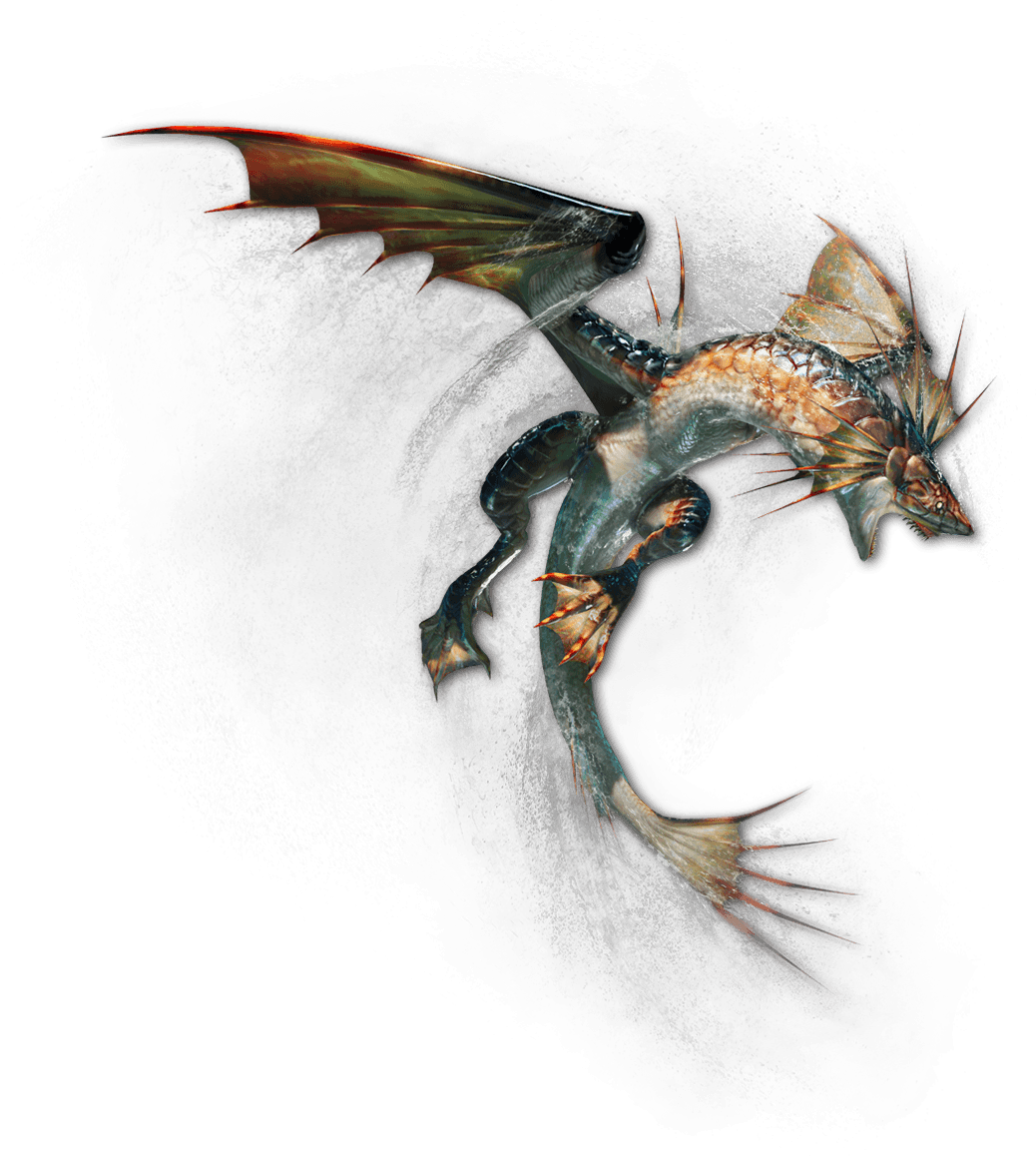
Jyuratodus
Huge wyvern (piscine), unaligned
- Armor Class 16 (natural armor)
- Hit Points 142 (15d12 + 45)
- Speed 30 ft., swim 30 ft.
STR DEX CON INT WIS CHA 20 (+5) 18 (+4) 16 (+3) 8 (-1) 12 (+1) 13 (+1)
- Damage Immunity cold, bludgeoning, piercing, and slashing from nonmagical weapons
- Senses darkvision 60 ft., passive Perception 11
- Languages -
- Challenge 11 (7,200 xp)
Wallow. The jyuratodus wallows in mud, covering itself in a thick layer, which grants the jyuratodus +3 AC for 1 minute or until it takes 25 damage in a single turn.
Actions
Multiattack. The jyuratodus makes two attacks, two Mud Ball attacks; or one Bite attack and one tail attack. It can replace one of the melee weapon attacks with a hip check attack while on land.
Hip Check. Melee Weapon Attack: +9 to hit, reach 5 ft., one target. Hit 24 (3d12 + 5) bludgeoning damage.
Bite. Melee Weapon Attack: +9 to hit, reach 10 ft., one target. Hit 15 (3d6 + 5) piercing damage.
Tail. Melee Weapon Attack. +9 to hit, reach 10 ft., one target. Hit 18 (3d8 + 5) bludgeoning damage.
Mud Ball. Range Weapon Attack: +9 to hit, reach 30/120 ft., one target. Hit 15 (3d6 + 5) bludgeoning damage.
Constricting Ambush.(recharge 5-6). The jyuratodus swims underwater and sends a target creature, within 60 feet flying into the air as it leaps up from the depths below. The target creature must make a DC 16 Dexterity saving throw, taking 49 (9d10) bludgeoning damage on a failed save or half as much on a successful save. If the target is Large or smaller, it is grappled (escape DC 16) Until this grapple ends, the target is restrained and takes 3 (1d6) bludgeoning damage at the start of the jyuratodus's turn. The jyuratodus can't Ambush another target while this target is grappled.
Jyuratodus
Jyuratodus is a mid-sized Piscine Wyvern that greatly resembles Lavasioth. Jyuratodus has light brown scales covering it, though these colors are usually hidden due to the mud on its body.
When left undisturbed, Jyuratodus won't bother anything within their territory. Once disturbed, however, Jyuratodus will turn aggressive and try to injure threats.
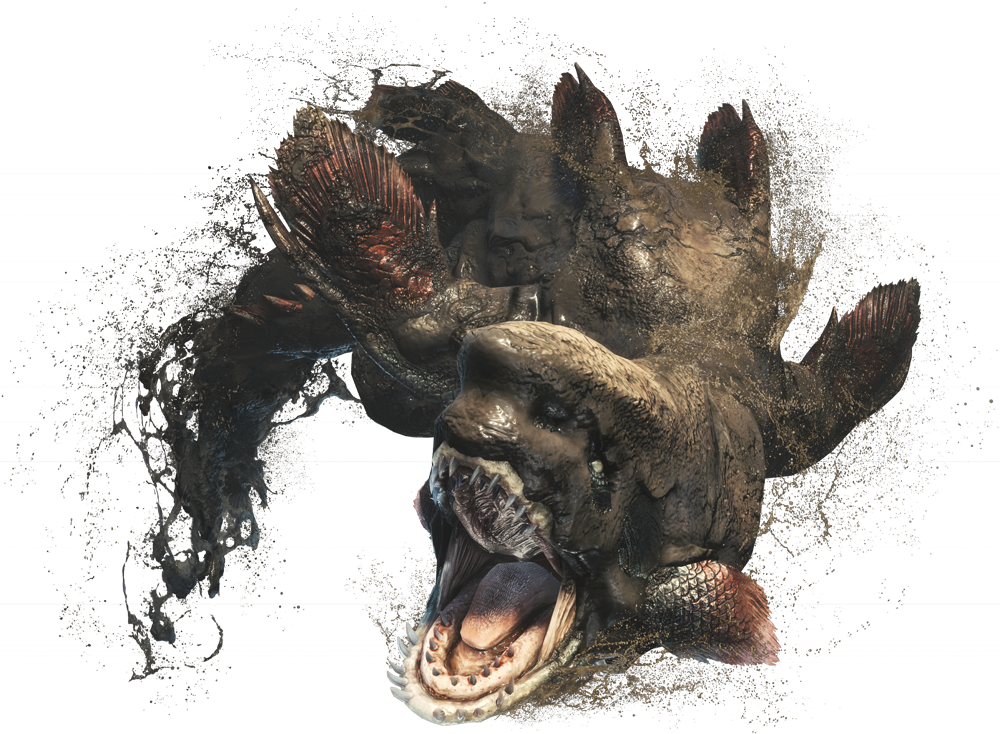
Lavasioth
Huge wyvern (piscine), unaligned
- Armor Class 15 (natural armor)
- Hit Points 149 (13d12 + 65)
- Speed 30 ft., swim 40 ft.
STR DEX CON INT WIS CHA 21 (+5) 18 (+4) 20 (+5) 16 (+3) 14 (+2) 12 (+1)
- Damage Immunity fire, bludgeoning, piercing, and slashing from nonmagical weapons
- Senses darkvision 60 ft., passive Perception 12
- Languages -
- Challenge 13 (5,000 xp)
Lava Armor. The lavasioth body is covered in a lava-like armor which hardens when cooled and softens when heated. At the start of its turn, if lavasioth is above ground, it gains +1 AC and its movement speed is reduced by 5 feet. to a maximum of +4 AC and -20 feet of movement. If the lavasioth takes fire damage, the bonus AC from this skill is reduced by 1 and movement is increased by 5 feet. The lavasioth can reset this effect by staying submerged in lava for one round.
Actions
Multiattack. The lavasioth makes three attacks, one Bite attack, one tail attack, and one hip check. It can replace any attack with the Magma Rock attack.
Bite. Melee Weapon Attack: +10 to hit, reach 10 ft., one target. Hit 15 (3d6 + 5) piercing damage.
Tail. Melee Weapon Attack. +10 to hit, reach 10 ft., one target. Hit 18 (3d8 + 5) bludgeoning damage.
Hip Check. Melee Weapon Attack: +10 to hit, reach 10 ft., one target. Hit 24 (3d12 + 5) bludgeoning damage.
Magma Rock. Range Weapon Attack: +9 to hit, reach 80/320 ft., one target. Hit 15 (3d6 + 4) bludgeoning damage plus 3 (1d6) fire damage.
Slither (recharge 5-6). The lavasioth up to its speed on its belly without provoking attacks of opportunity, during this move it may move through other creatures. Any creatures the lavasioth moves through must succeed on a DC 18 Dexterity saving throw, taking 18 (4d8 + 5) bludgeoning damage plus 13 (4d8) fire damage and knocked prone on a fail.
Legendary Actions
The lavasioth can take 3 legendary actions, choosing from the options below. Only one legendary action option can be used at a time and only at the end of another creatures turn. The lavasioth regains spent legendary actions at the start of its turn.
Detect. The lavasioth makes a Wisdom (Perception) Check.
Check (Costs 2 Actions). The lavasioth makes one Hip Check attack.
Lavasioth
Lavasioth is a bipedal Piscine Wyvern that resides in lava rather than water. Its body is covered with hardened magma, forming a tough outer shell. Its head is fish-like in nature, with rounded features and large, circular eyes. Its mouth is filled with sharp, needle-like fangs. Its legs are large with hard rock scales and end in fins rather than claws. Unlike other Piscine Wyverns, Lavasioth lacks wing-like fins. Instead, it has only a pair of medium-length pectoral fins. It has a long, thick tail to assist in when swimming through the thick magma it resides in.
Lavasioth are very well adapted to live in their habitat. Having a layer of hardened lava, coal, and ore on its skin makes it very durable. They also have the ability to spit lava, which is used to attack prey, or any other monsters that may pose a threat. Lavasioth are powerful swimmers in lava and their speed in swimming through the volcanic rock is matched only by the magma-dwelling Leviathan known as Agnaktor. During the mating season, female Lavasioth will cover themselves in rare volcanic ores in order to attract a mate, giving them a reddish-crimson color.
Lavasioth are extremely territorial and will attack any monster or human that enters its area with ferocity, excluding one of its own kind.
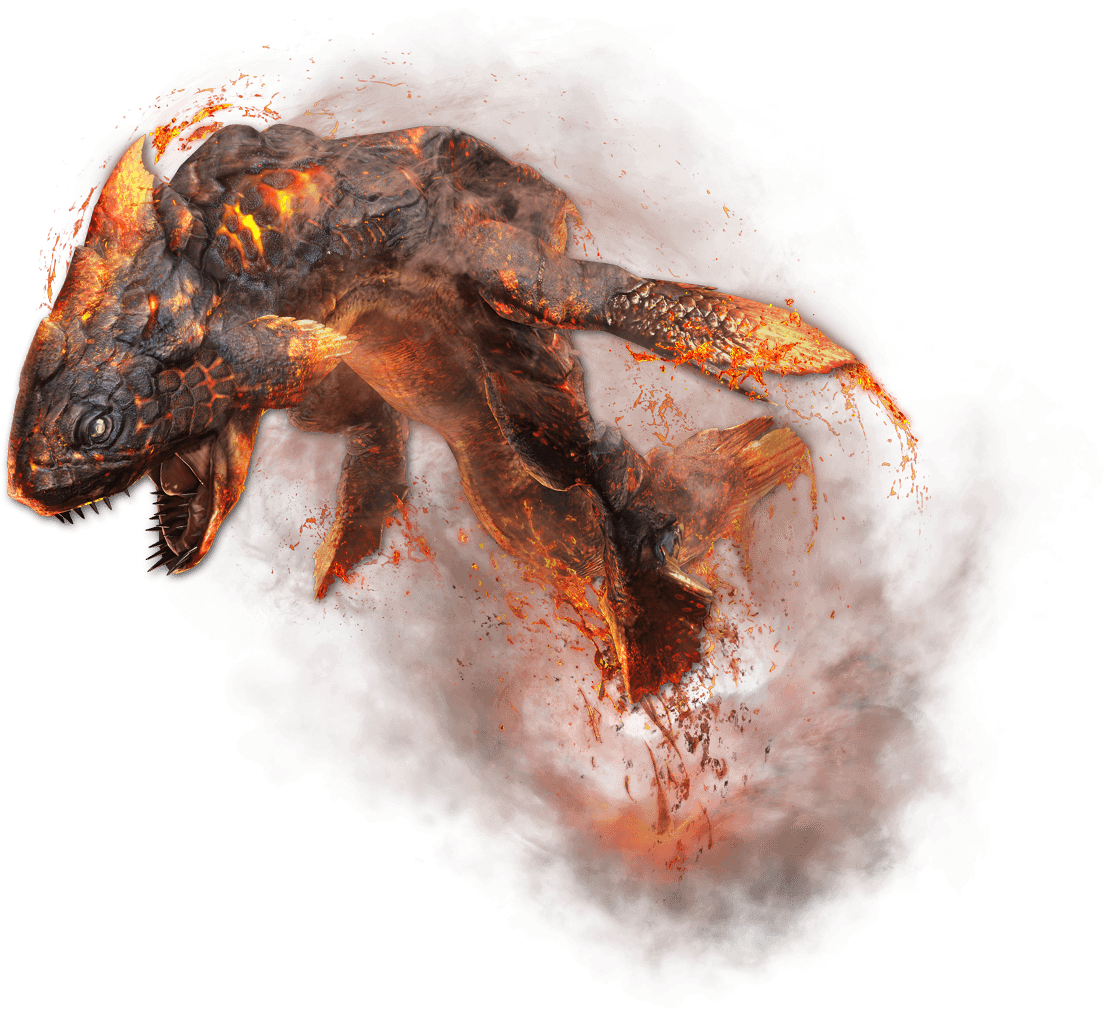

Thank you
For
Checking this out
Thank you all for using this Monster hunter Monster Manual. I created a few monsters originally because I wanted to use them in my own campaign and progressed into this Monster Manual we have today.
This section is 23 pages of monsters from the series and I am pretty proud to say I created them. I hope you all enjoy using these creatures as much as I plan too and this is not the end.
The Monster Manual might be done, but thanks to a few ideas from users on Reddit. I plan on creating a compendium with loot tables for materials, all of the weapons from the videogame series, and rules for using these monsters in your own Monster Hunter D&D game.
If you are interested in letting me know what you think. Feel free to stop by my Twitch channel or check out my Patreon. Thank you for reading and I hope this book serves you well.
Art
Most art, except the cover art, has been gathered from https://monsterhunter.wikia.com website and edited if needed to fit the page. The few others are listed below.
Lore
Most Lore, about these monsters, was also gathered from https://monsterhunter.wikia.com and then edited to omit any mention of missing skills and make the lore more in line with a D&D setting.